Antique & Decorative Ceramics
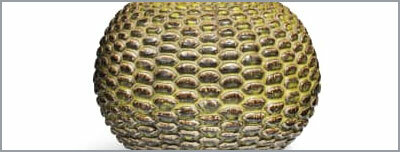
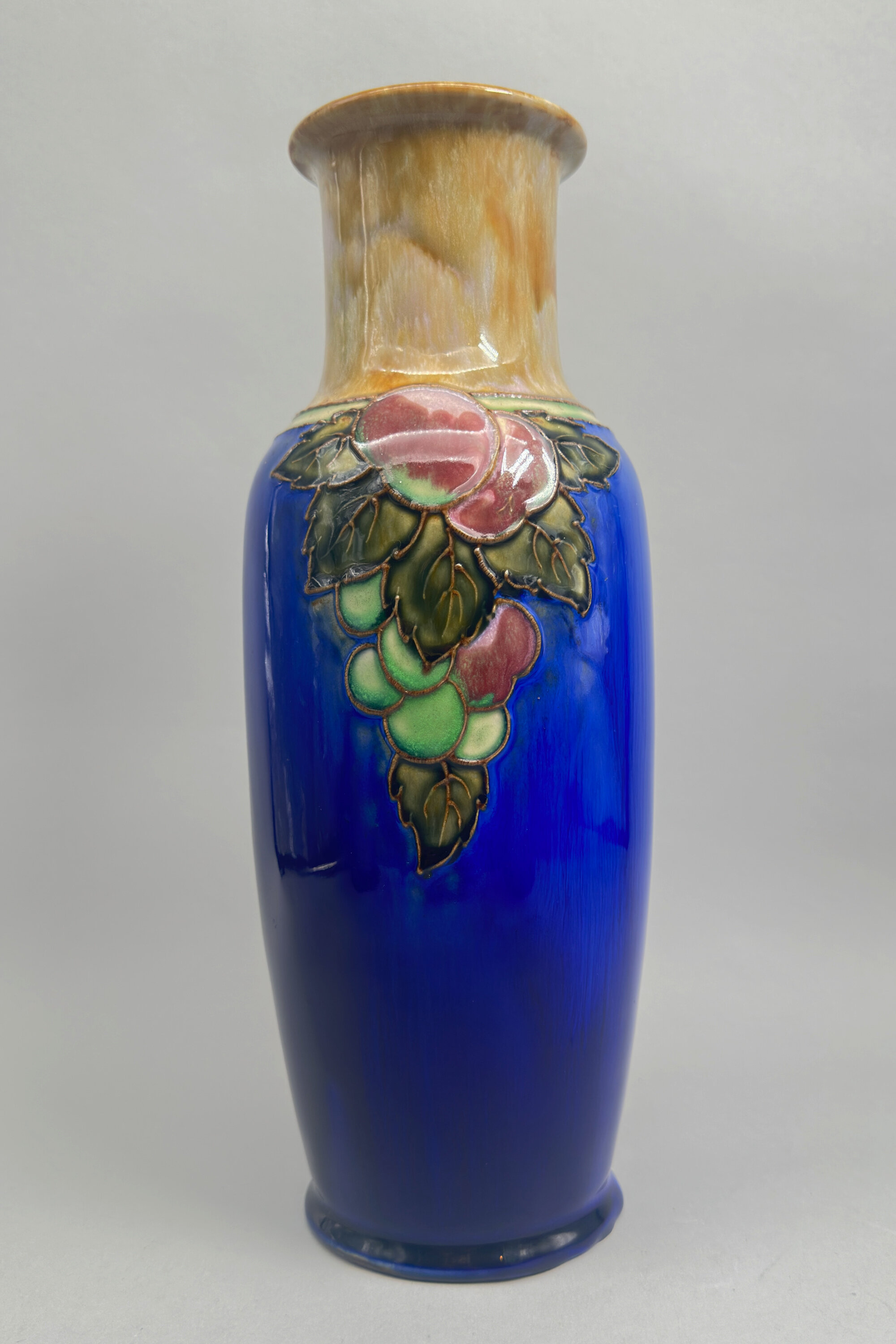
Doulton Vase with raised grape and peach decoration, 1920s
Price: £110The mark for Doulton is one of the standard impressed 'Royal Doulton England' marks where the lettering forms part of a circle combined with three thick lines and the centre is filled with four interlocking 'D's. The addition of a lion but not with the usual accompanying crown allows a fairly precise dating to between 1923 and 1927, although the pattern number beginning with ‘X’, which appears on other pieces with similar decoration but a different shape, is supposedly found on pieces made for couple of years thereafter. Either way, the mid to late 1920s dating fits with both the form and the decoration which have a distinctly Art Deco feel. The mark ‘P’ is for the decorator Lizzie Padbury but the scratched mark cannot be identified. Presumably the second set of numbers indicate the shape.
Royal Doulton produced many pieces reflecting the Art Deco style and other similar vases can be found on this site. They are an elegant reinterpretation producing pieces of great decorative appeal.
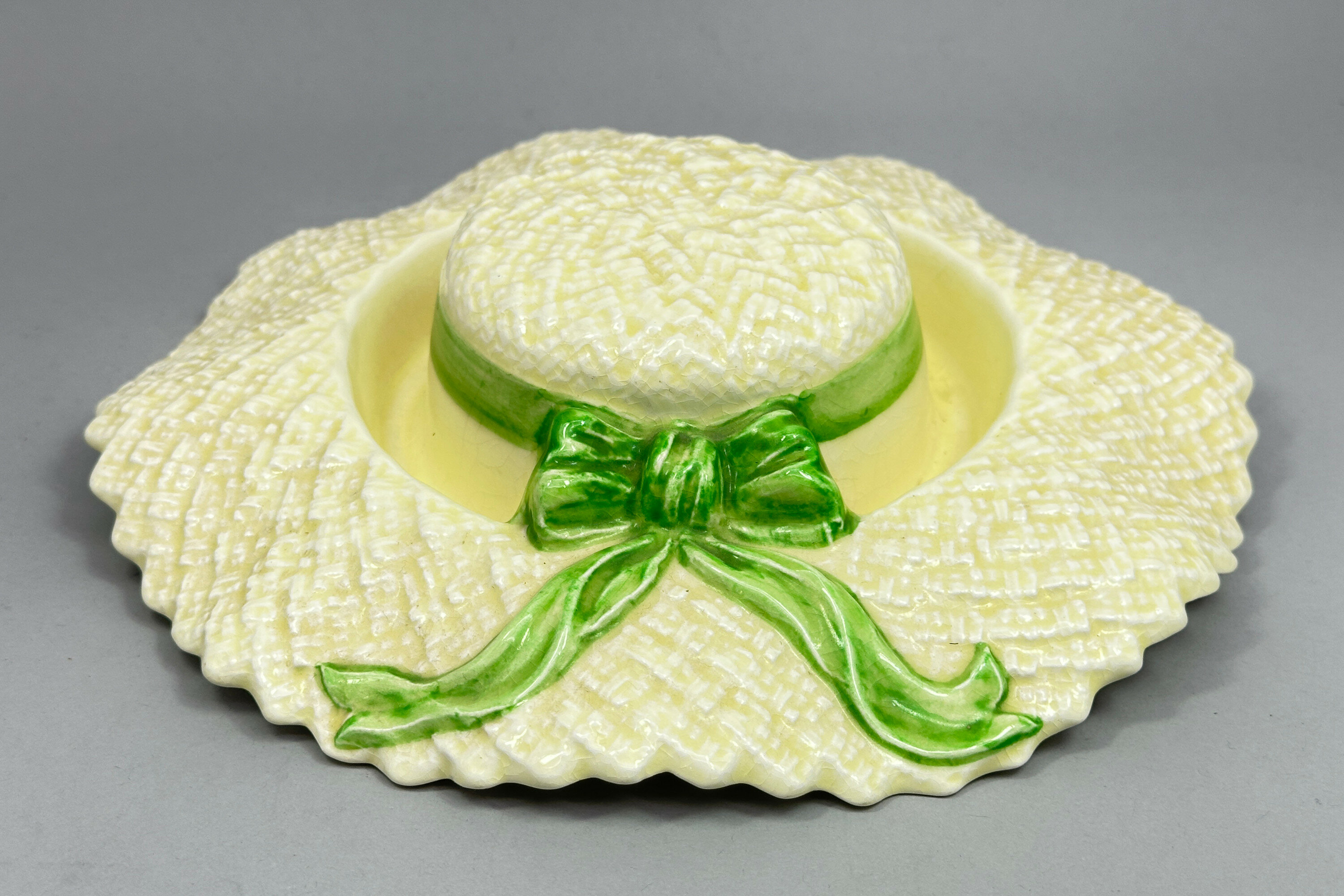
Novelty Bonnet Posy Vase, 1940s/1950s
Price: £25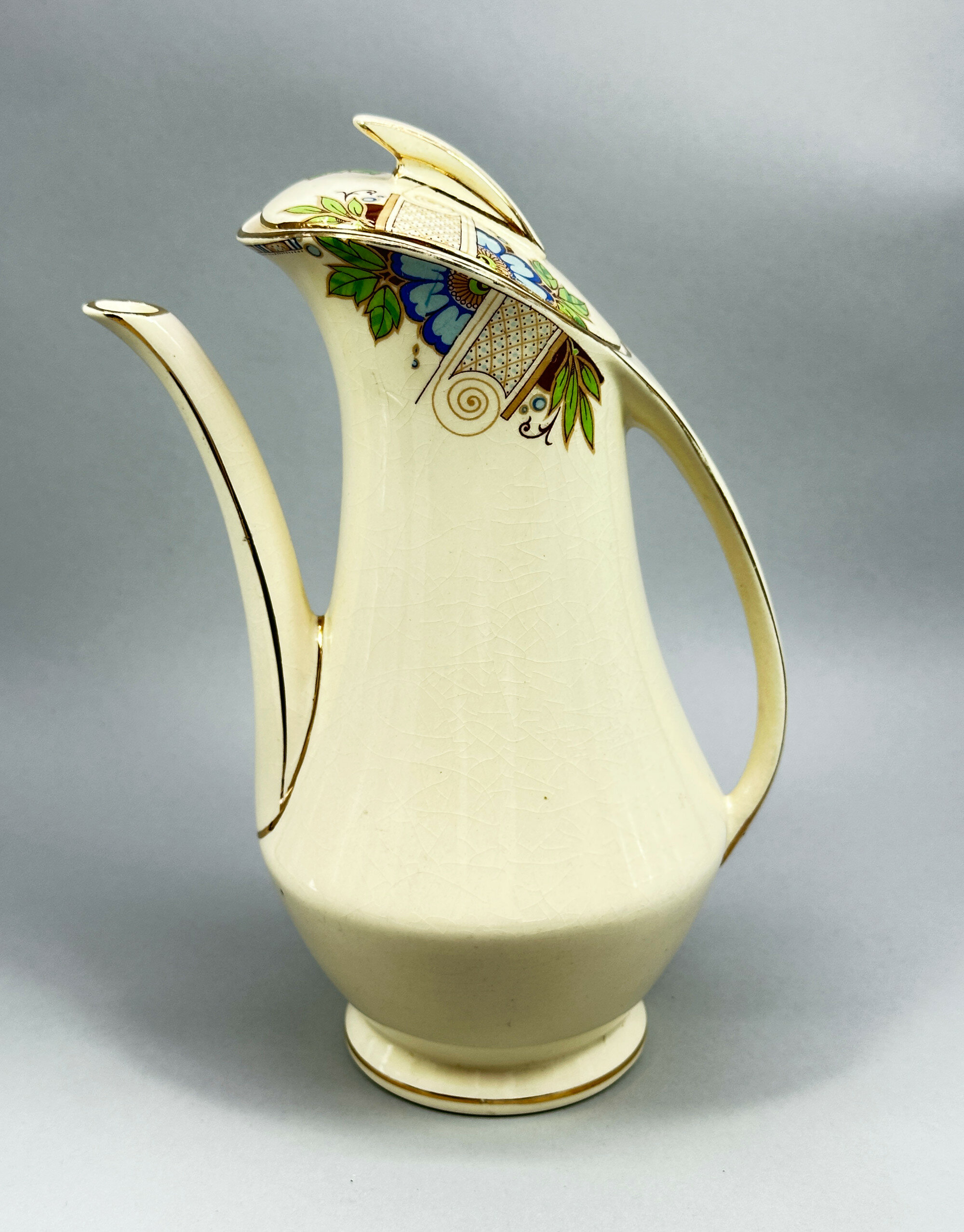
Art Deco Coffee Pot, Crownford Burslem, Staffordshire 1930s
Price: £35Burslem in Staffordshire was one of the famous six ‘pottery towns’ and immortalised in the novels of Arnold Bennett as ‘Bursley’. The firm Thomas Ford and Sons began its production there in the late nineteenth century, continuing until 1938 when the business was purchased by Oswald Shufflebottom who renamed it Ford & Sons (Crownford) Ltd. The trade name ‘Crownford’ had been adopted quite early on by the Ford family and was kept by the Shufflebottom family until the late 1980s. The ‘Crownford Burslem’ wares were mostly produced in the fashionable Art Deco style during the late 1920s and 1930s and this coffee pot is a fine and representative example of their work.
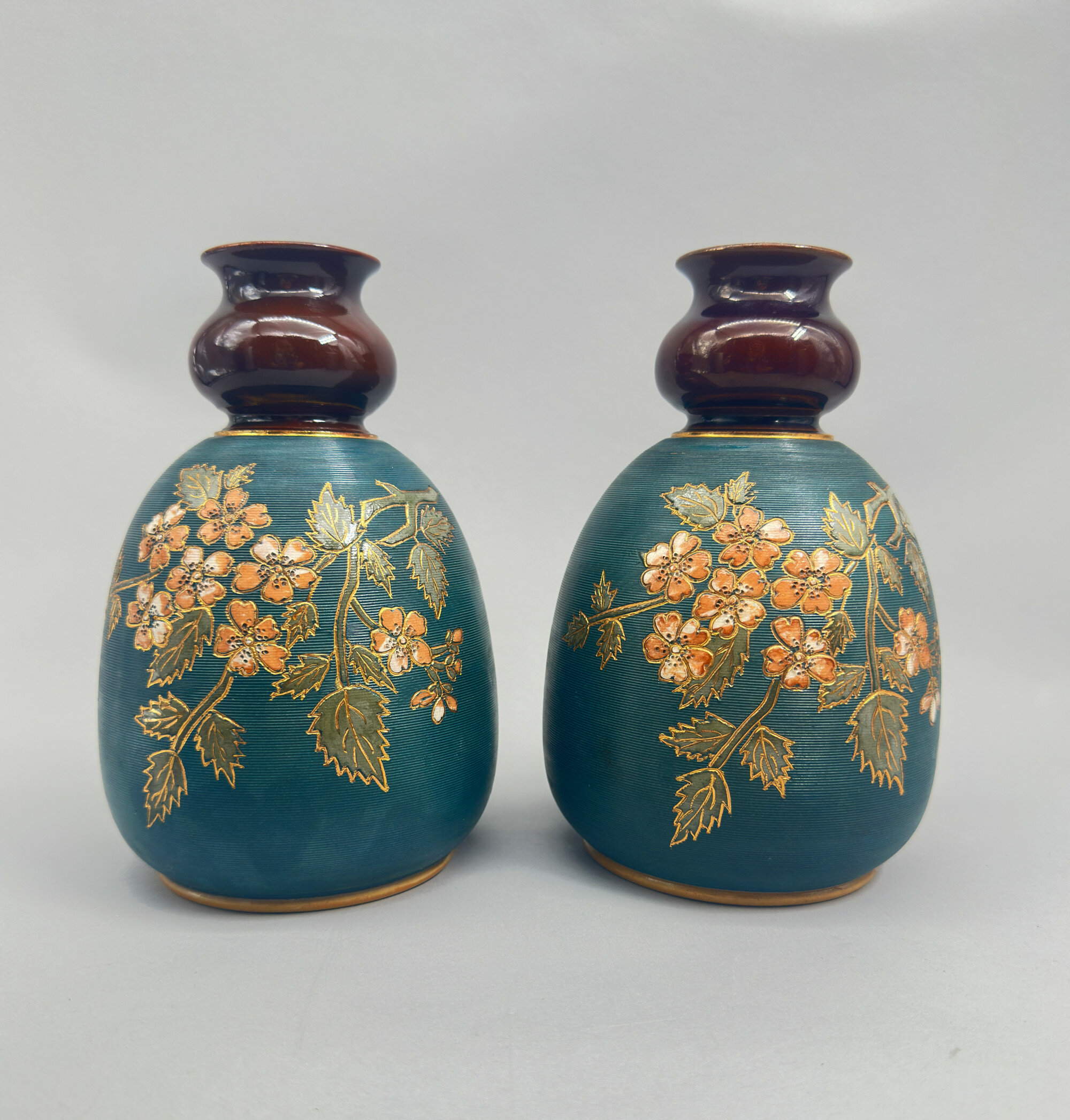
Pair of Lovatt and Lovatt Langley Mill Vases, early C20th
Price: £85The Langley Mill Pottery was located in Langley Mill, Derbyshire on the Derbyshire – Nottinghamshire border. From its establishment in 1865 to its final closure in 1982, it went through five distinct periods of ownership, producing a wide range of stoneware ranging from utilitarian items and to high quality art pottery. This pair of vases dates from the third company that traded there, Lovatt and Lovatt. The Lovatt family had entered into partnership with the owner of the founding business at Langley Mill, James Calvert. From 1895 the business was in sole control of the Lovatt family and traded as ‘Lovatt and Lovatt’ until 1935. The early years of the twentieth century proved to be something of a zenith for them and a wide range of art pottery pieces were made which enjoyed great popularity. Production techniques were streamlined without a reduction in quality and in 1905, leadless glazes were introduced. These are proudly announced on the base of this pair of vases which are an excellent example of the Lovatt and Lovatt style and probably date to 1912, indicated by the impressed numbers for that year.
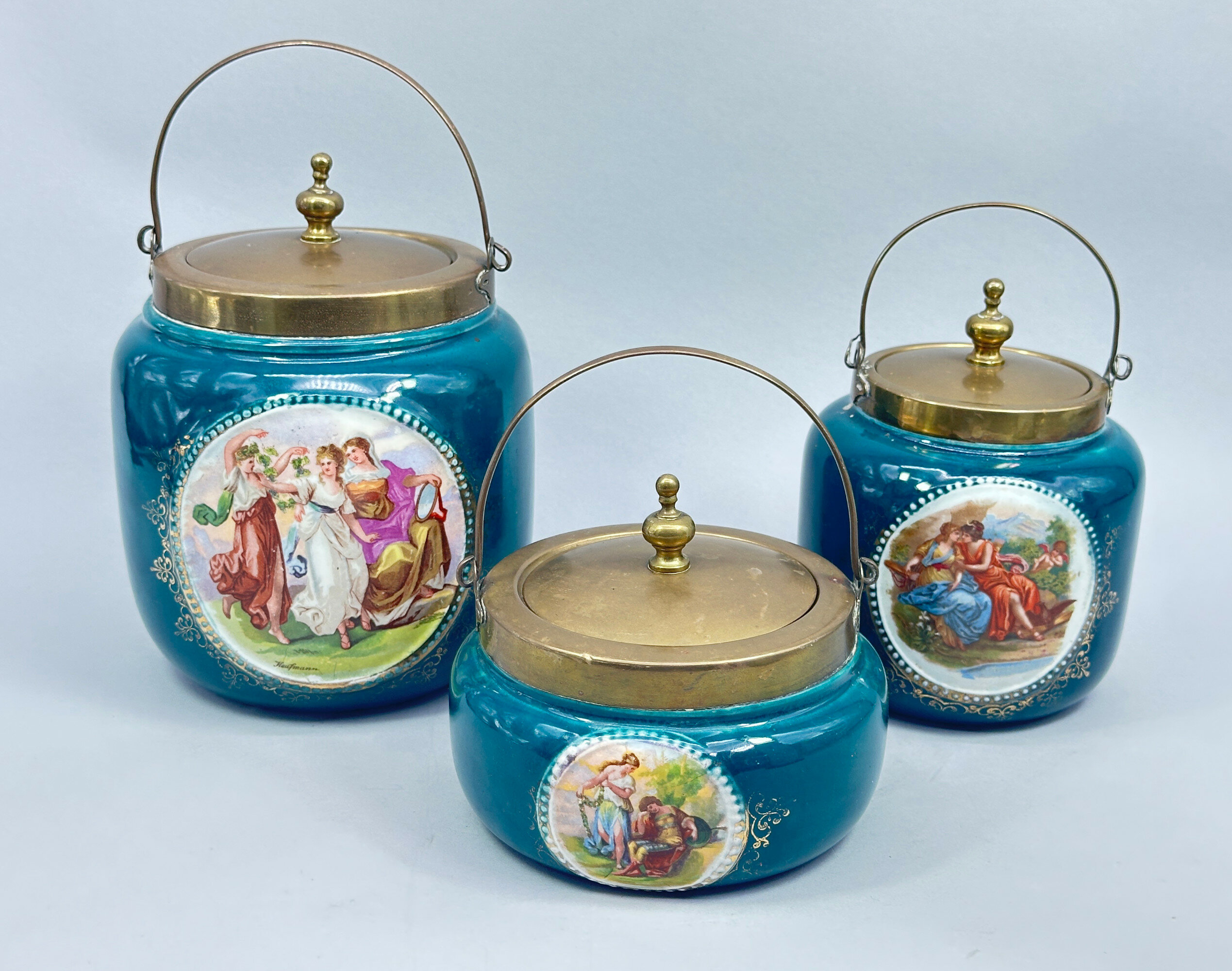
Set of Three Empire Porcelain Company Biscuit Jars circa 1900
Price: £120The Empire Porcelain Company was established in 1896 at the Empire Works in Stoke Road, Hanley, Stoke on Trent. A wide range of pottery and porcelain was subsequently produced until the factory’s closure in 1967. The various marks include the initials EPC, EP or the word Empire. The form of the mark seen here occurs on the earliest pieces made between 1896 and 1912. Blue ground pieces with mythological scenes were produced in a variety of forms during this period, some decorative, such as ornamental vases, and some more practical, as here : modest but graceful accessories for the Edwardian drawing room.
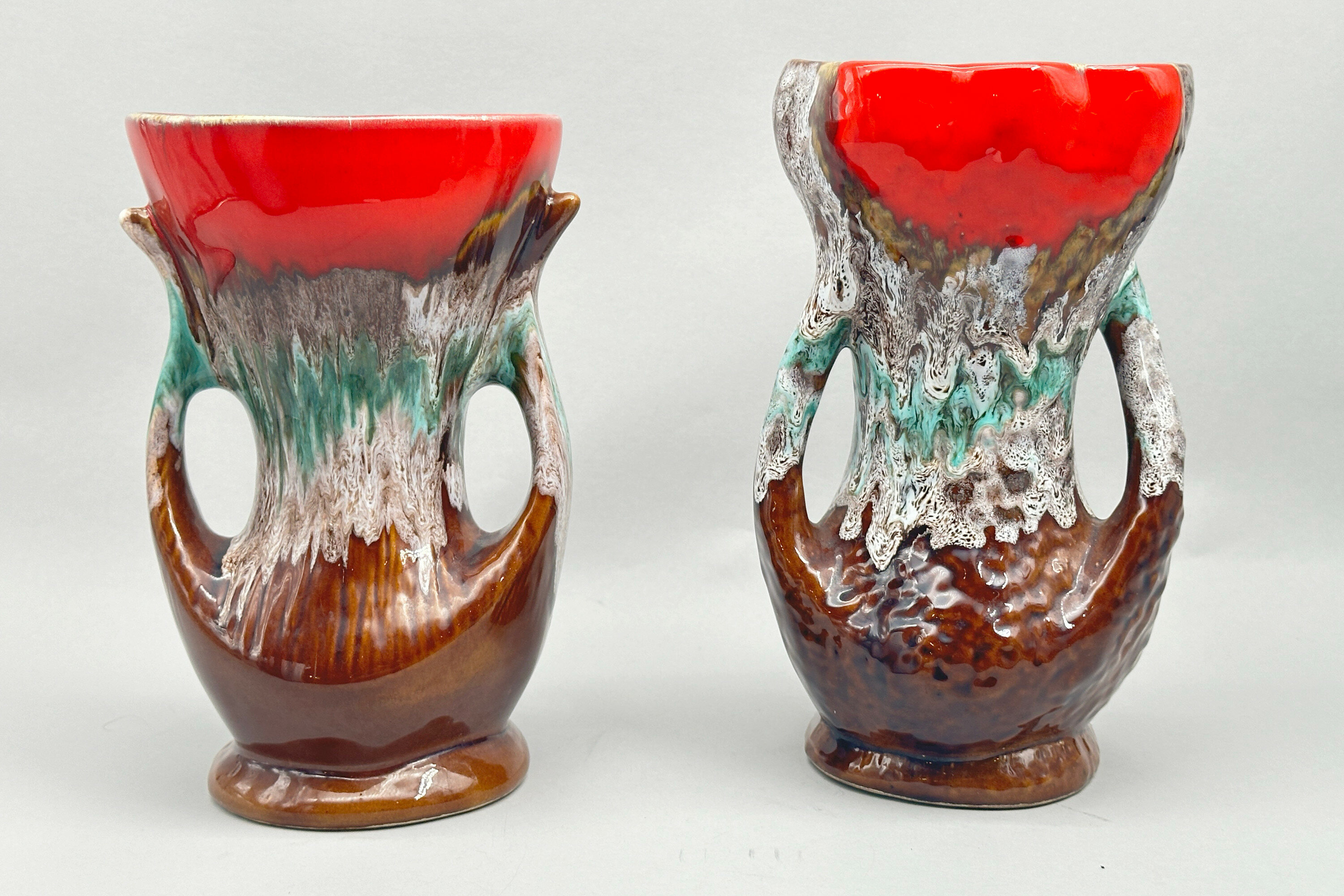
Two Vallauris Lava Vases, French 1950s/1960s
Price: £150………………………………………………………………………………………………….....................................................................
Vallauris is a tourist town of the French Riviera near Antibes taking its name form the Provencal ‘Valauria’ meaning ‘the golden valley’. It is divided into two parts: the upper town which is the old centre and the seaside district which runs from the port along the coast, towards Antibes. Deposits of clay were found there in Roman times giving the impetus for the creation of potteries which tended to concentrate on domestic wares. Production was then continuous with an infux of craftsmen from Genoa, Italy, in the sixteenth century and the development of artistic activity in the seventeenth. The advent of the railways in the late nineteenth century led to an even further expansion of production and companies were established there which achieved widespread fame and recognition notably those of Massier and Foucard-Jourdan.
After the war, Picasso, along with a group of fellow artists, settled in Vallauris and it proved to be a congenial stimulus. He began to experiment with producing ceramics in 1947 and was to continue working extensively in this field until his death in 1973 (see image 12). There were collaborations, one with the ceramicist Robert Picault and another with Suzanne and Georges Ramié, the owners of the Madoura workshop, where Picasso worked on his productions. Indeed it was at the Madoura workshop that Picasso met Jacqueline Roque, a saleswoman working there and 44 years his junior. They married in 1961 and remained together until his death in 1973, Jacqueline being the inspiration for many of the designs which Picasso created.
It would be fanciful, though, to see the influence of the famous artist on these vases although they were very much created in the tradition of Vallauris pottery with which he was so in sympathy. The town seems to have become particularly fashionable in the 1950s and 1960s and it was around that time that these vases were made. Many pieces were created in lead glazed earthenware, the overall decoration resembling the ‘lava’ glazes used in West German pottery of the same period. These two vases are similar and complementary. The bodies are concave with a short foot and a widely flaring mouth; there are loop handles at each side. The brown glaze at the base is succeeded by a blend of mottled greens and greys and topped with a vibrant red at the mouth. The interiors are glazed brown as is the base with the unglazed foot rim showing the fairly coarse clay used. Some but not all Vallauris pieces are marked and there are many unmarked examples as here. Considerable skill must have been required to produce the variety of glaze effects and the results are striking. As two matching items, these vases have considerable decorative appeal and are worthy examples of a long established tradition of ceramic production.
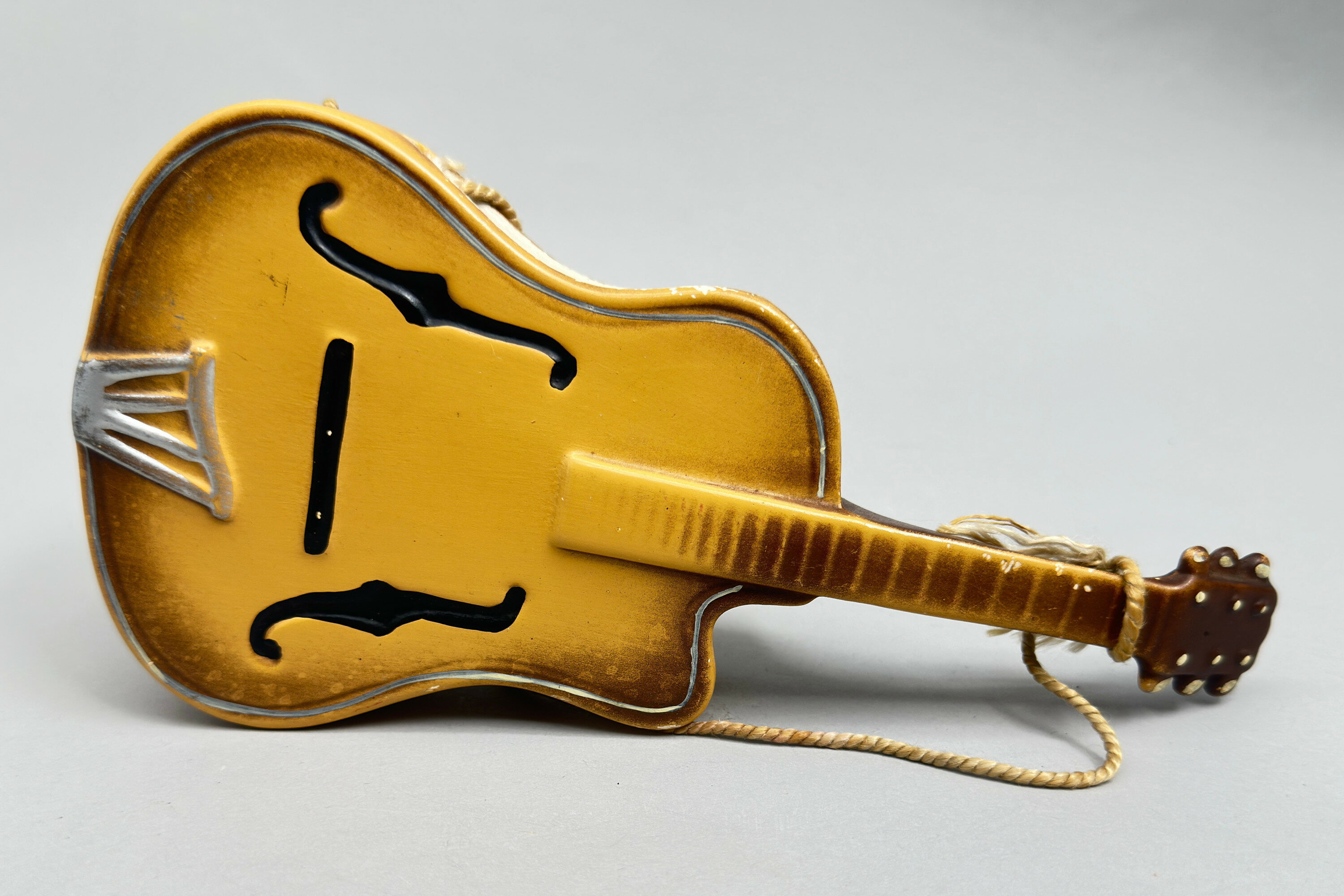
Novelty ceramic Wall Vase in the form of a Gretsch Guitar, English, 1950s
Price: £25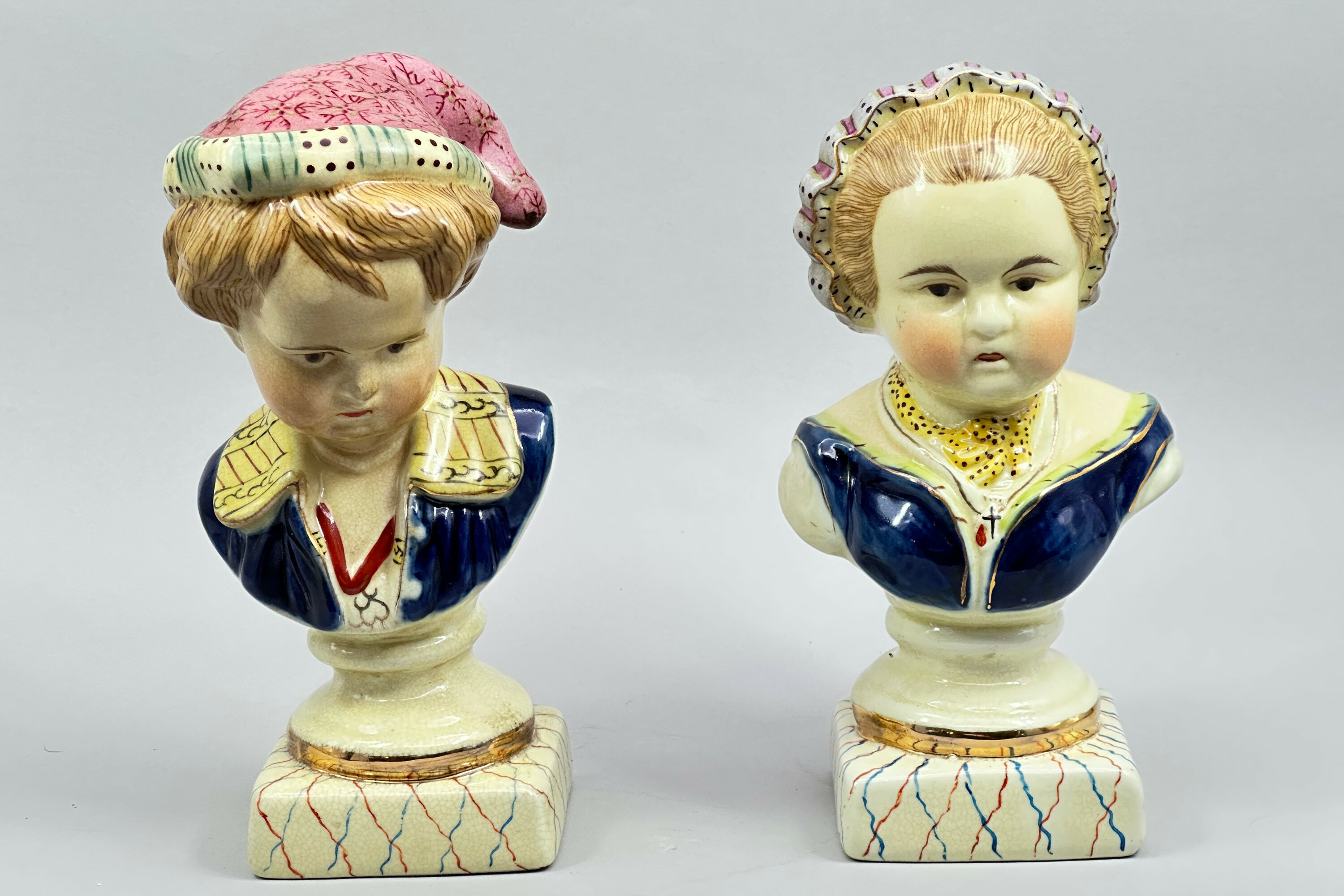
Pair of Staffordshire style Vintage Busts of Children, C20th
Price: £75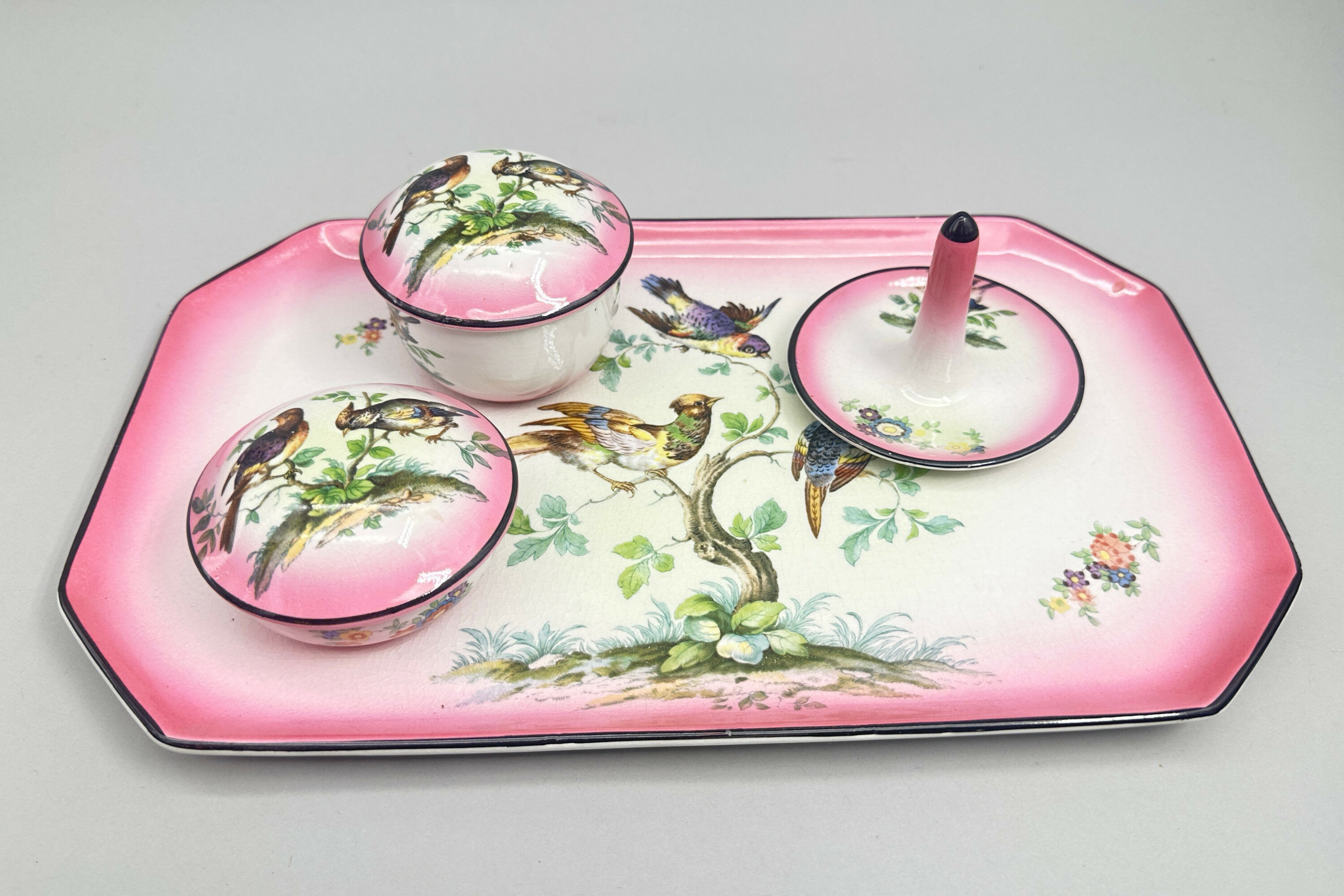
Kiralpo ware Dressing Table Set, marked, 1930s
Price: £35Kiralpo ware was one of the trade names used by Kirkland and Co, earthenware and ceramic manufacturers based at the Albion Pottery, Etruria, Stoke-on-Trent, England who traded from 1891 to 1938 when the business was bought and renamed by Mr A.E.Gray. The format of the mark gives a dating between 1928 and 1938 with ‘E’ standing for Etruria. Kirkland and Co made various modest but colourful decorative items to furnish the home. In a 1907 guide they are described as ‘general earthenware, fancy goods, and majolica manufacturers’. Their designs were not sophisticated but obviously had a popular appeal and this set with its bold transfer decoration of birds set within a rather vivid pink border is typical of their work.
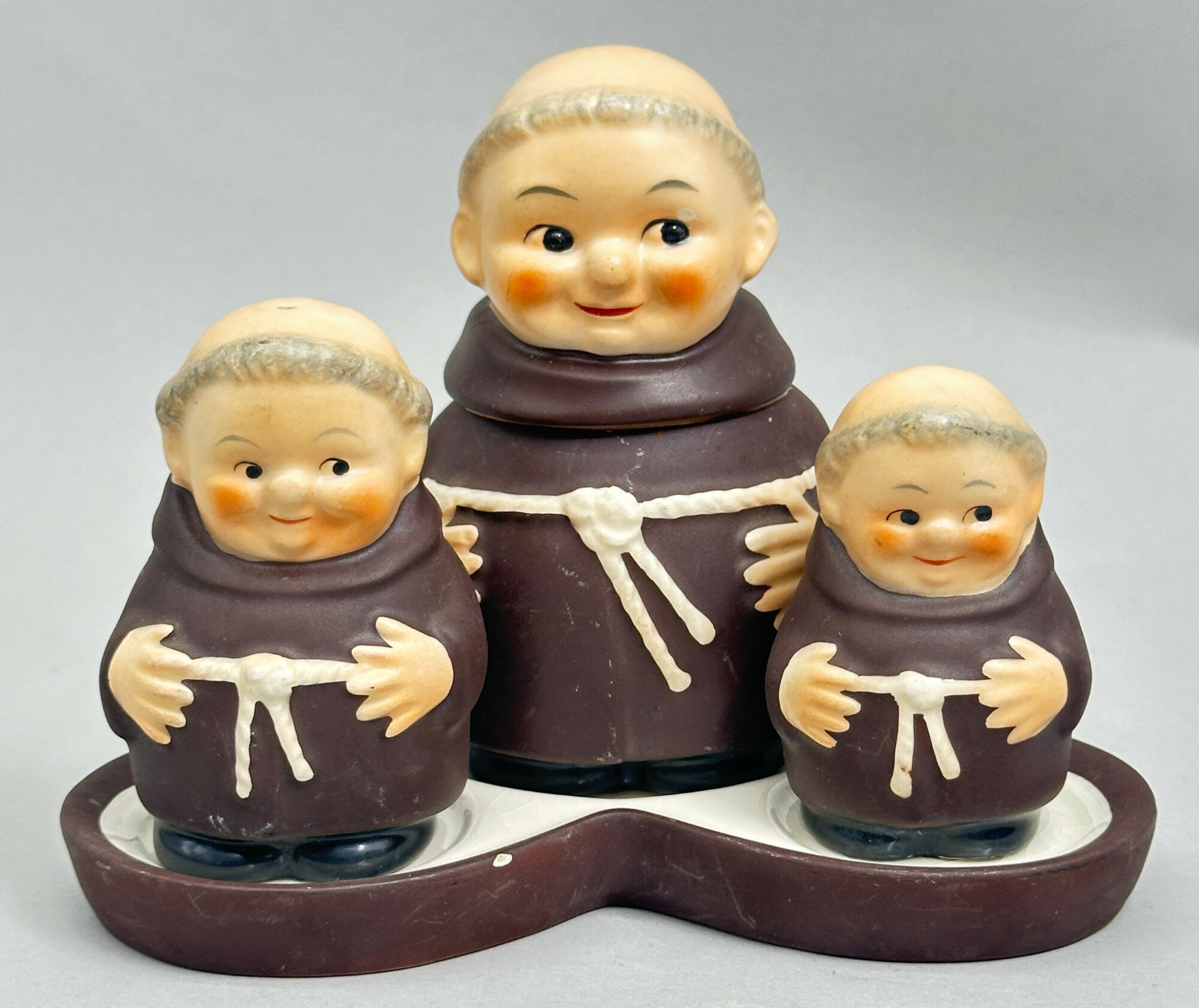
Cruet set in the form of three Friar Tuck Monks on a Tray, Hummel, West Germany, 1960s
Price: £55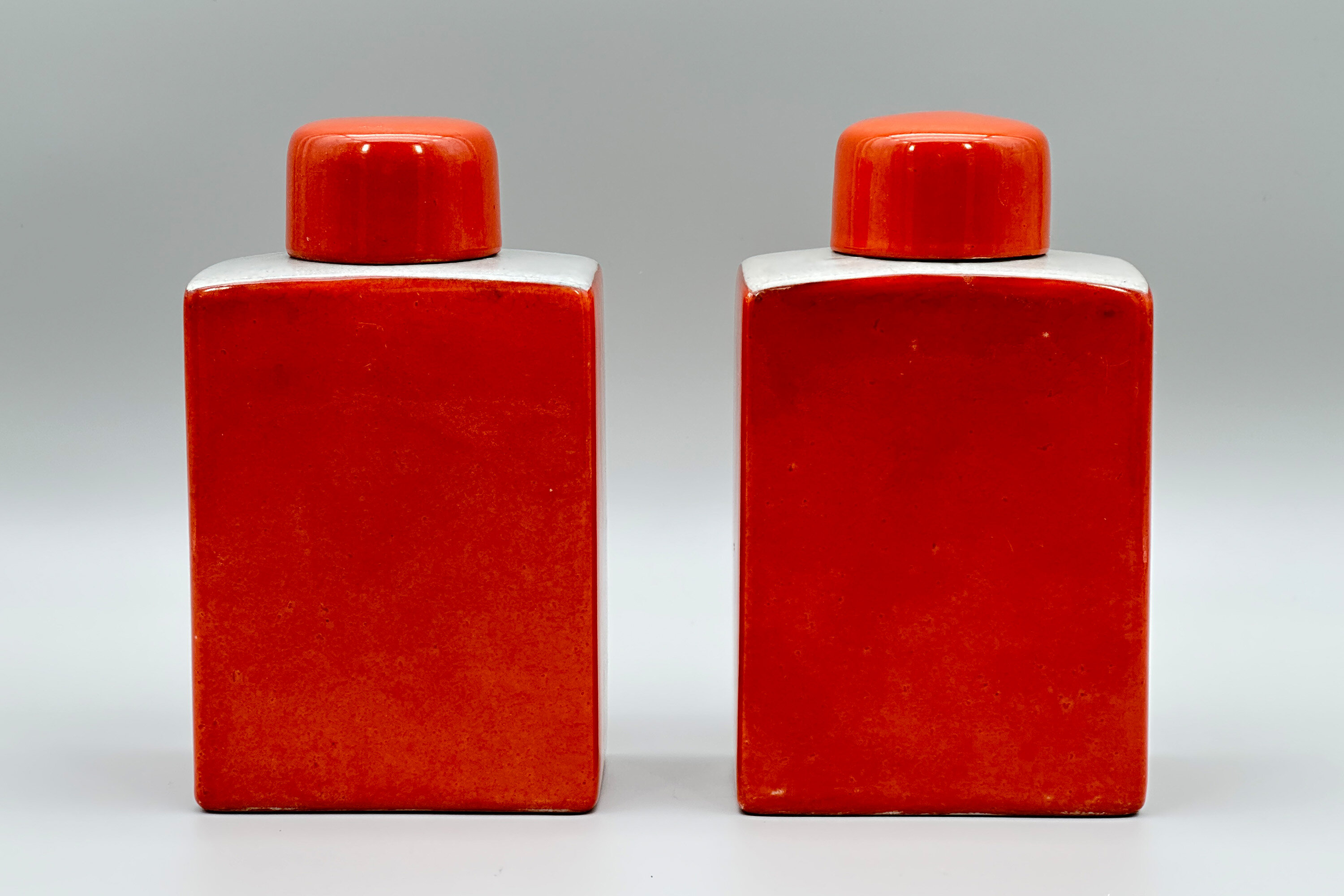
Pair of Orange Glazed Flasks and Covers, Fabienne Jouvin Paris, C20th
Price: £150The French designer Fabienne Jouvin (see image 9) graduated from the superior school of applied arts Duperré in 1985. Since then, she has travelled the world collecting designs for pieces sold and exhibited under her name internationally, with a studio based in Paris. On her website, she writes “From my travels - from Tokyo to The Habana, from the streets of Paris to the sea bed of The Maldives - I bring back sketchbooks, pads of notes, drawings and collages: hispanic or contempory architectures, faces reminding those of Piero Della Francesca, enigmatic objects non identified... These spontaneous sketchbooks give rise to unique pieces and editions painting, textile, porcelain, cloisonné...”. Her first exhibition was in 1989 and in 1996 she began an association with the firm ‘Asiatides’ allowing her to create pieces made in China and Thailand and utilising their designs and techniques.
This pair of flasks, possibly intended as tea caddies, are typical of her ability to give a ‘twist’ to the pieces from which she draws her inspiration. The shape is Chinese from the seventeenth century (see image 10), while the iron red colour is found on Chinese pieces two hundred or more years later. Combining this with a white ‘crackle glaze’, also well known from Chinese ceramics, was Jouvin’s own idea completing the mix of ancient and modern. Marked as from the Asiatides range with the stylised ‘A’, pieces like these are no longer available currently implying that they were probably made early on in her association with the firm and now have a uniqueness of their own.
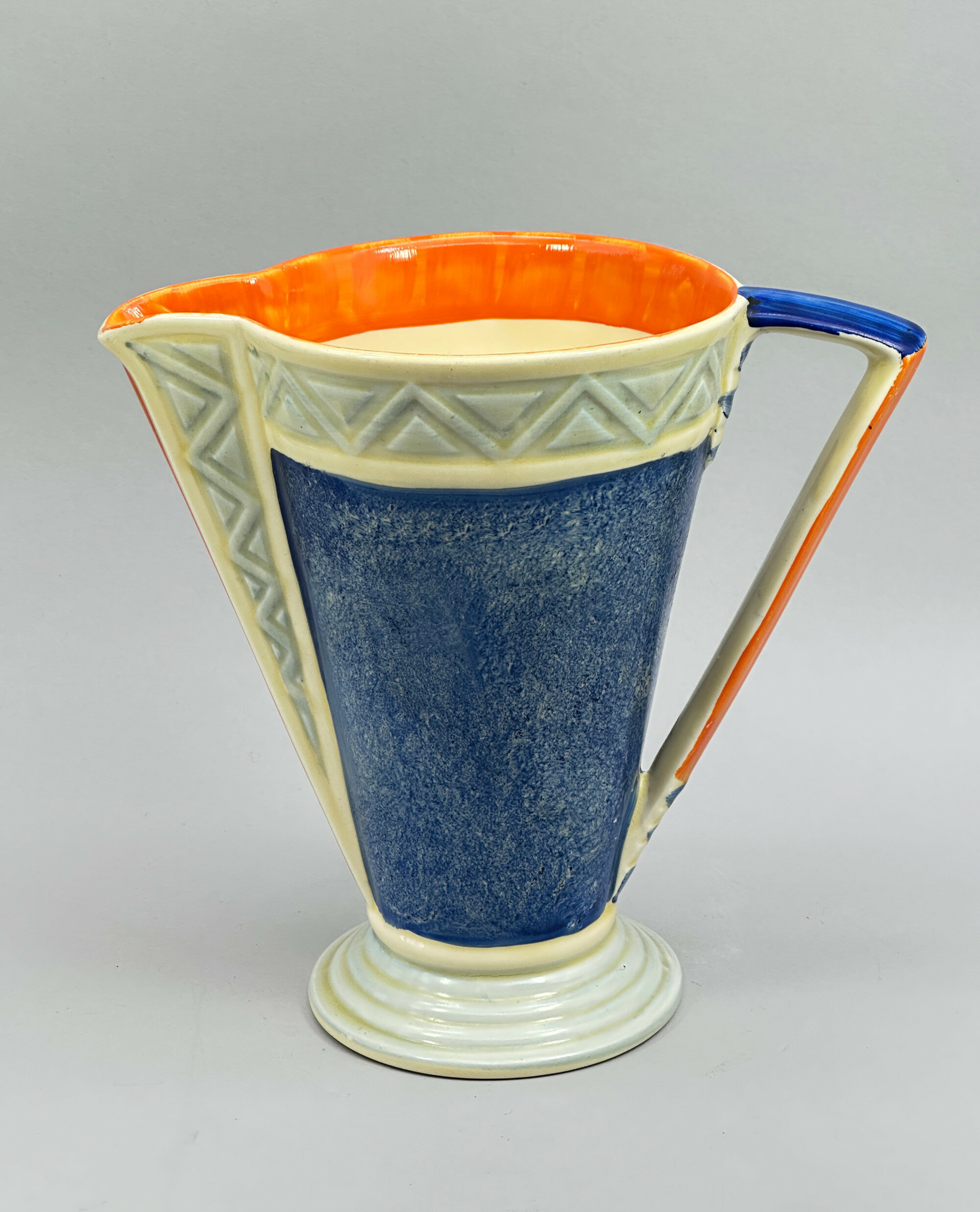
Myott Son & Co Art Deco style Jug, 1930s
Price: £75Myott Son & Co was one of famous the Staffordshire Potteries and traded for over 90 years. Founded in 1898, it began production in Stoke moving to Cobridge four years later. Its output was continuous but in 1949 the firm suffered a disastrous fire which reportedly destroyed the firm's records and pattern books and probably for this reason it relocated to Hanley. In 1969 it was bought by the American firm Interpace, but the Myott name was retained until 1976 when the company merged with Alfred Meakin Ltd, who were based in Tunstall, to form Myott-Meakin Ltd.
Myott now are best known for their Art Deco inspired designs from the 1930s. Following the success of their competitors, most notably the designs of Clarice Cliff, Myott established their own popular following and produced pieces which could rival the output of their celebrated competitors. This jug, with its clean lines and bold colours is an excellent example and like others of the same form bears the pattern umber ‘8498’. Some of their glazes were easily subject to wear and blue was less commonly used so both the condition and the colour range of this jug make it a highly desirable collector’s item.
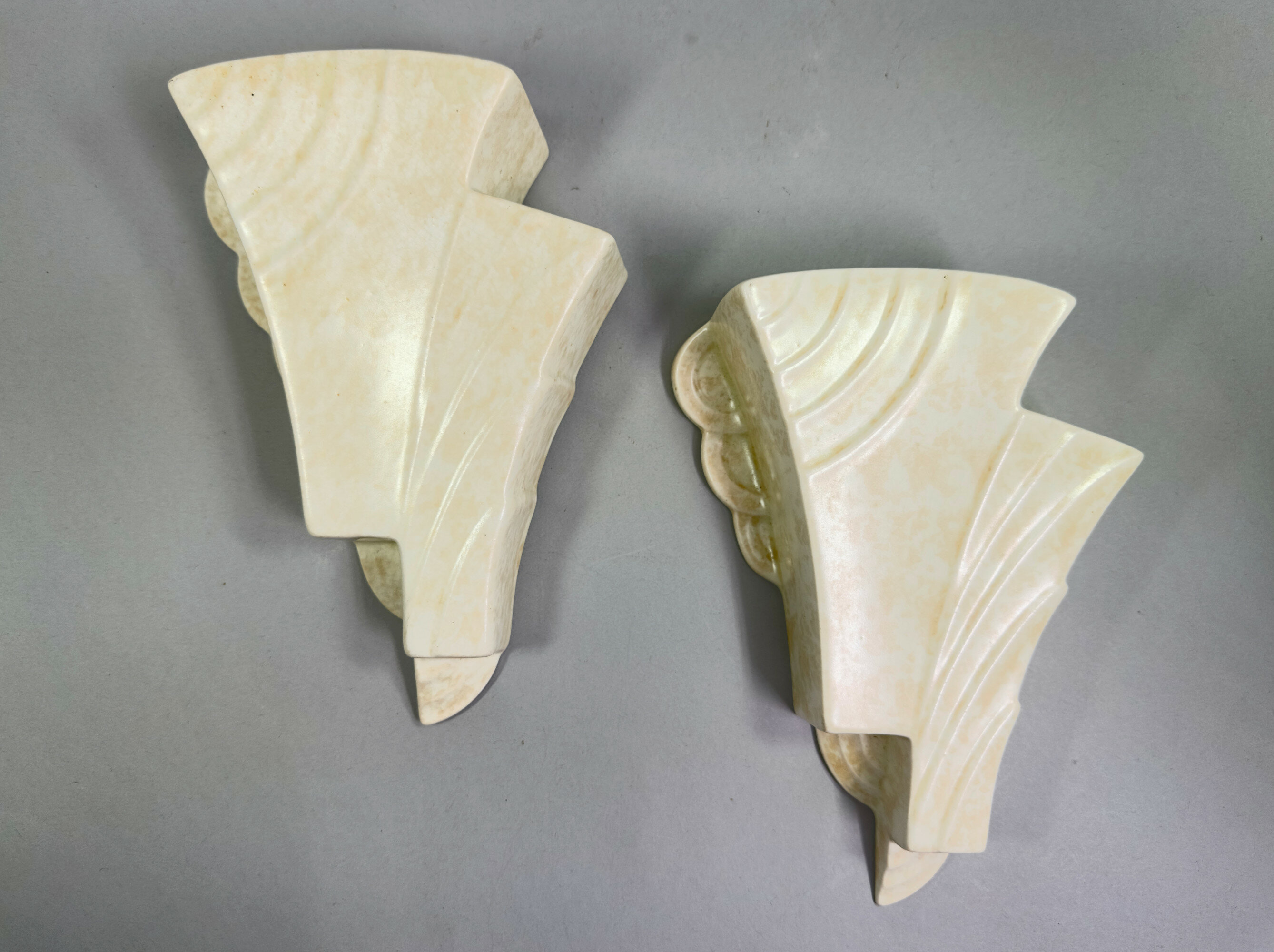
Pair of Art Deco Style Wall Pockets, C20th
Price: £55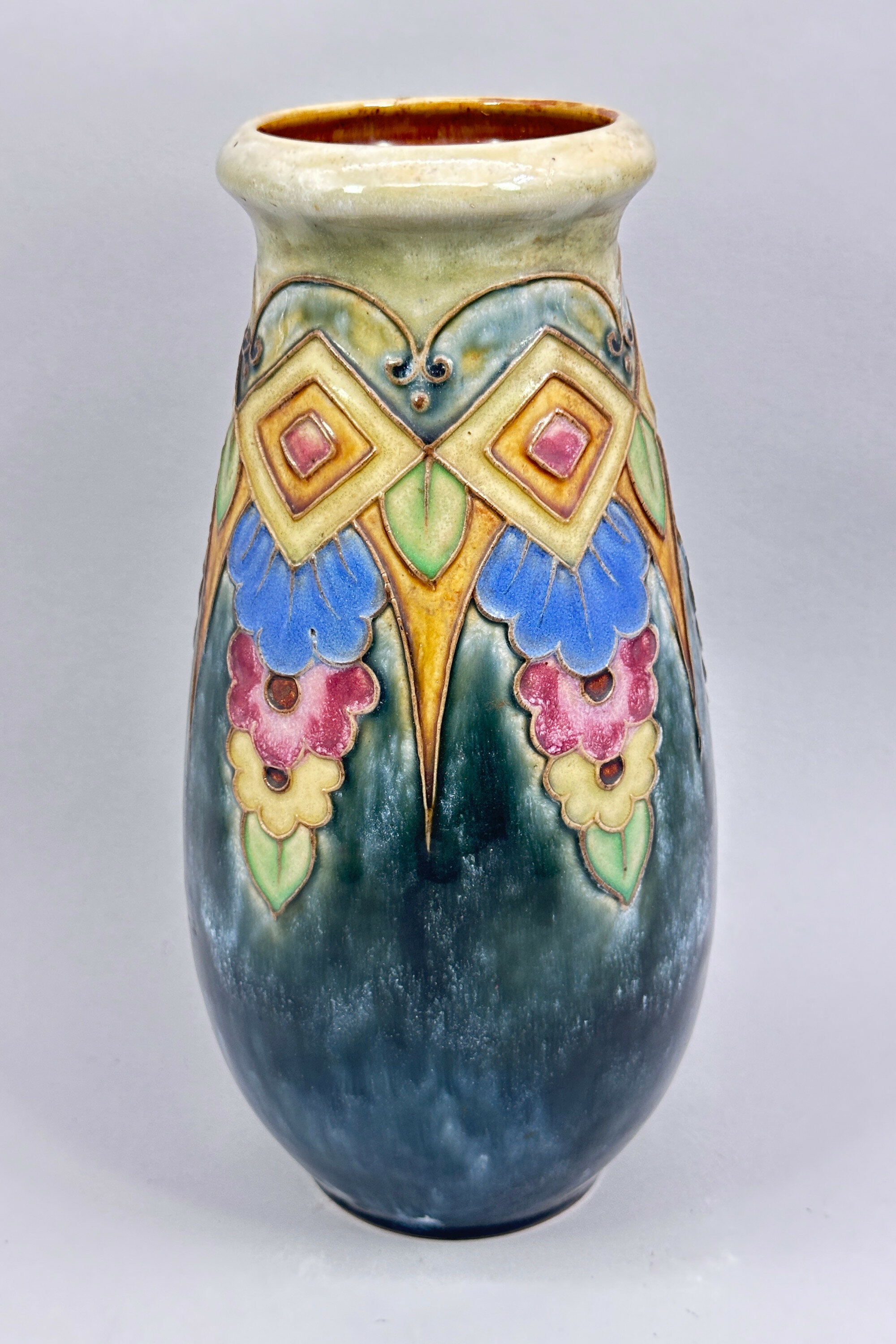
Doulton Vase with geometric and floral designs, late 1920s
Price: £75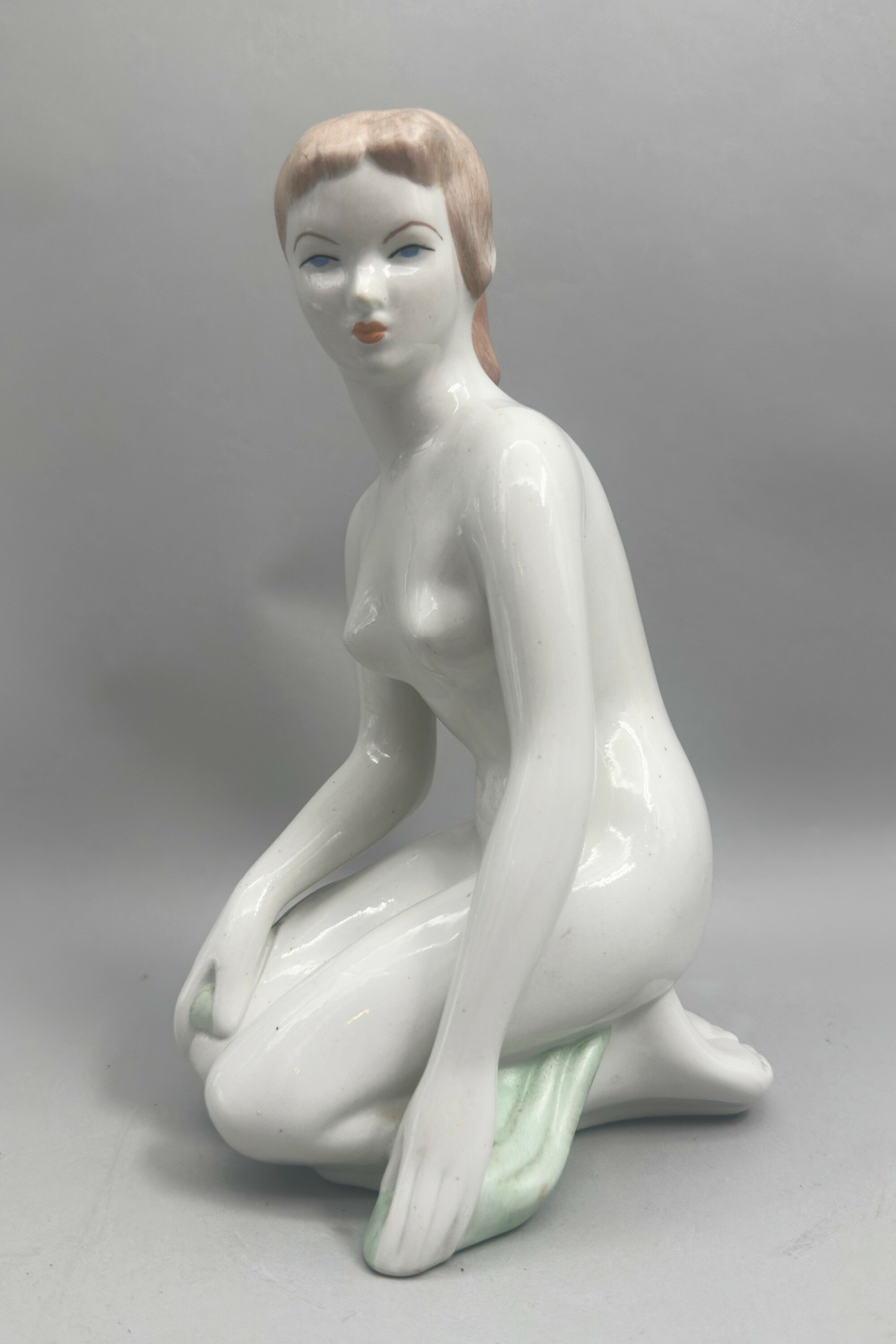
Art Deco style kneeling figure of a Girl, Aquincum Hungary, second half C20th
Price: £75Aquincus was an ancient Roman settlement, eventually to become the town Obuda, the third of the three cities which were merged to form Budapest and the oldest district in the Hungarian capital. In 1854, Hüttl Tivadar set up a shop in Pest selling porcelain eventually becoming involved in porcelain manufacture itself with such success that by the early 1900s he was supplying the court at Buda, eventually supplanting the rival firm of Herend. Despite legal battles amongst the family concerning the ownership of the business, the firm continued to prosper until the 1950s when the new communist government decided to nationalize the factory, renaming it Aquincum Porcelángyár. Tableware, which had been the staple of the Hüttls’ production was replaced by figurines which rapidly enjoyed great popularity. One of the principle artists was Antonia Szabó who became chief designer in 1966. With the end of socialism, the firm went into private hands in 1993 but suffered an immediate and rapid decline causing it to close soon after.
This figure may possibly, then, have been designed by Szabó himself but it is certainly typical of the pieces produced in the early years of state control and perhaps one of the most appealing. The form of the mark corresponds with a dating to the 1950s or 1960s and the piece has both historical associations and considerable decorative appeal.
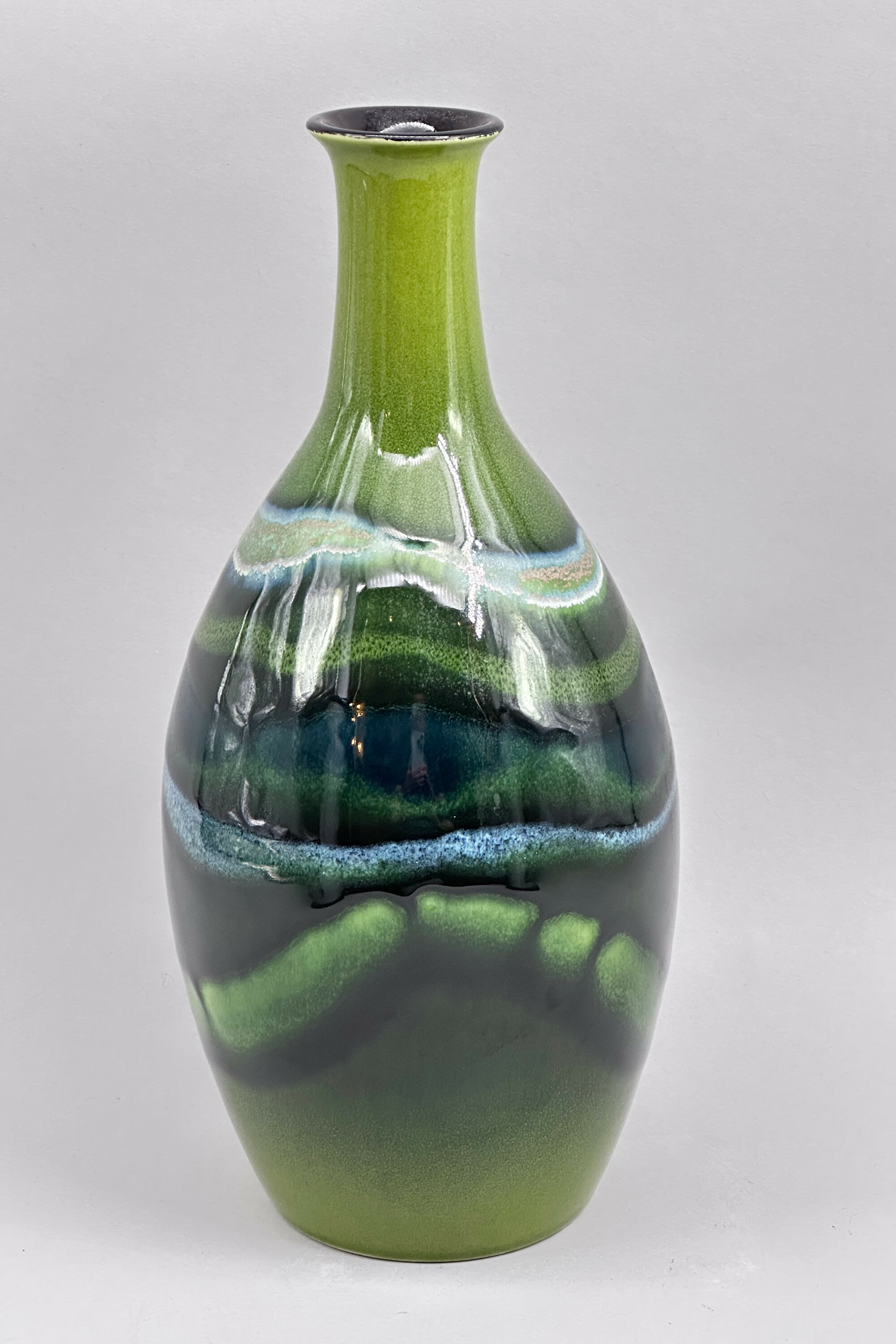
Poole Pottery Maya Pattern Bottle Vase, early C21st
Price: £85This fine quality vase is from the Maya range made by Poole Pottery, some of the pieces still being in production today and described in the maker’s catalogue as follows “Poole Pottery’s Maya collection is inspired by British landscapes and earthy tones. The greens and blues in this stunning range represent the earth meeting the sky in a natural yet bold design. Here at Poole Pottery, all our Maya ceramics are hand-cast and made using our signature reactive glaze in the famous Middleport Pottery in Staffordshire. The distinctive pieces you see here are created via our Living Glaze technique, where layers of colourful glazes react with one another to create a unique, glossy and dynamic finish.” But this particular form does not appear in the current catalogue and does not seem to be otherwise available. The form of the mark appears on other Poole pieces of more recent manufacture and dating is probably to around twenty years ago. The initials are for the artist’s signature and Poole write “Items are personalised with the artist's own individual mark, adding value to the collectability of each piece.” Given its scarcity, this vase would make an interesting addition to a collection of Poole Pottery aside from being a highly decorative item in its own right.
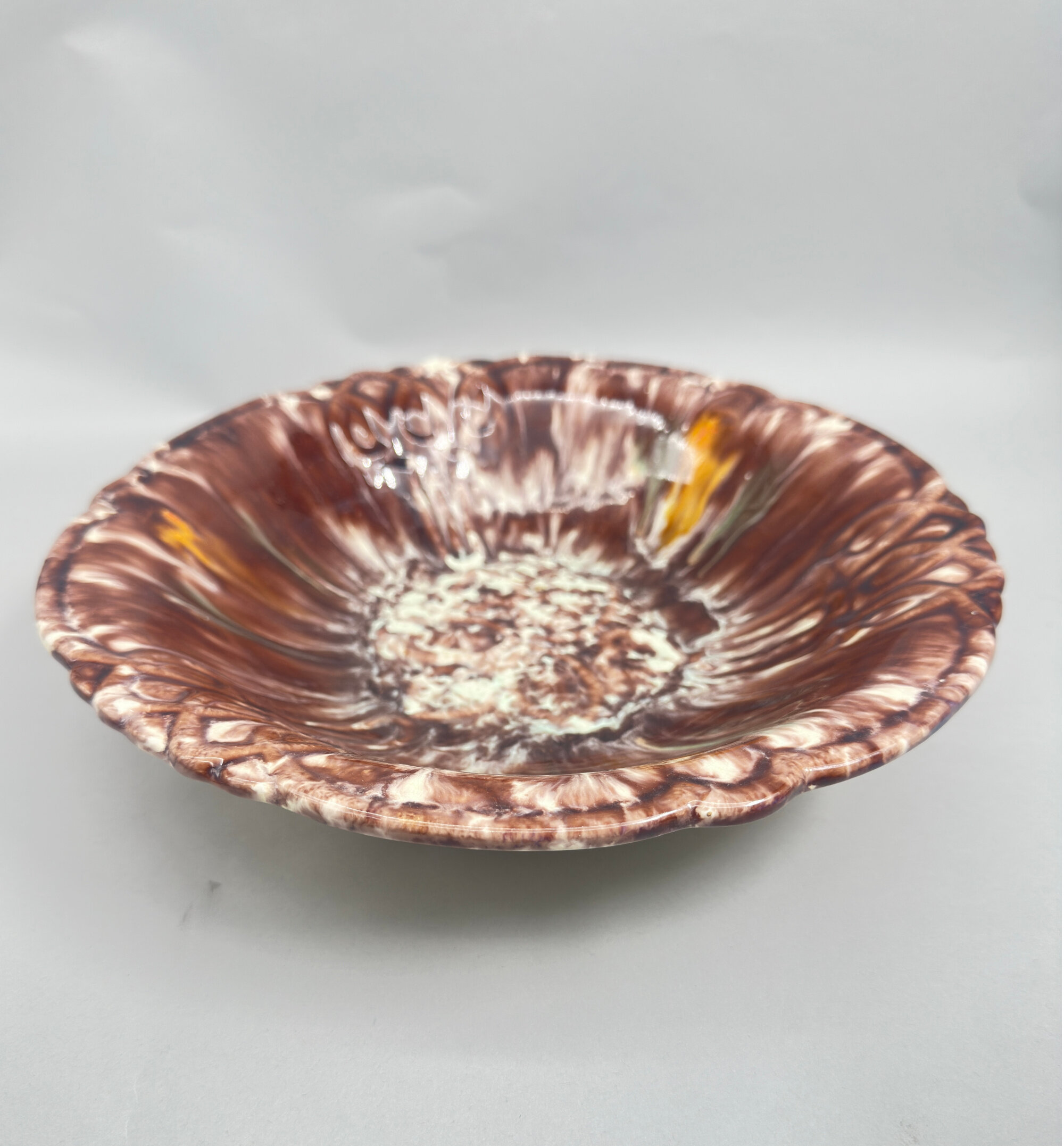
Majolica Footed Fruit Bowl, Germany, 1930s
Price: £55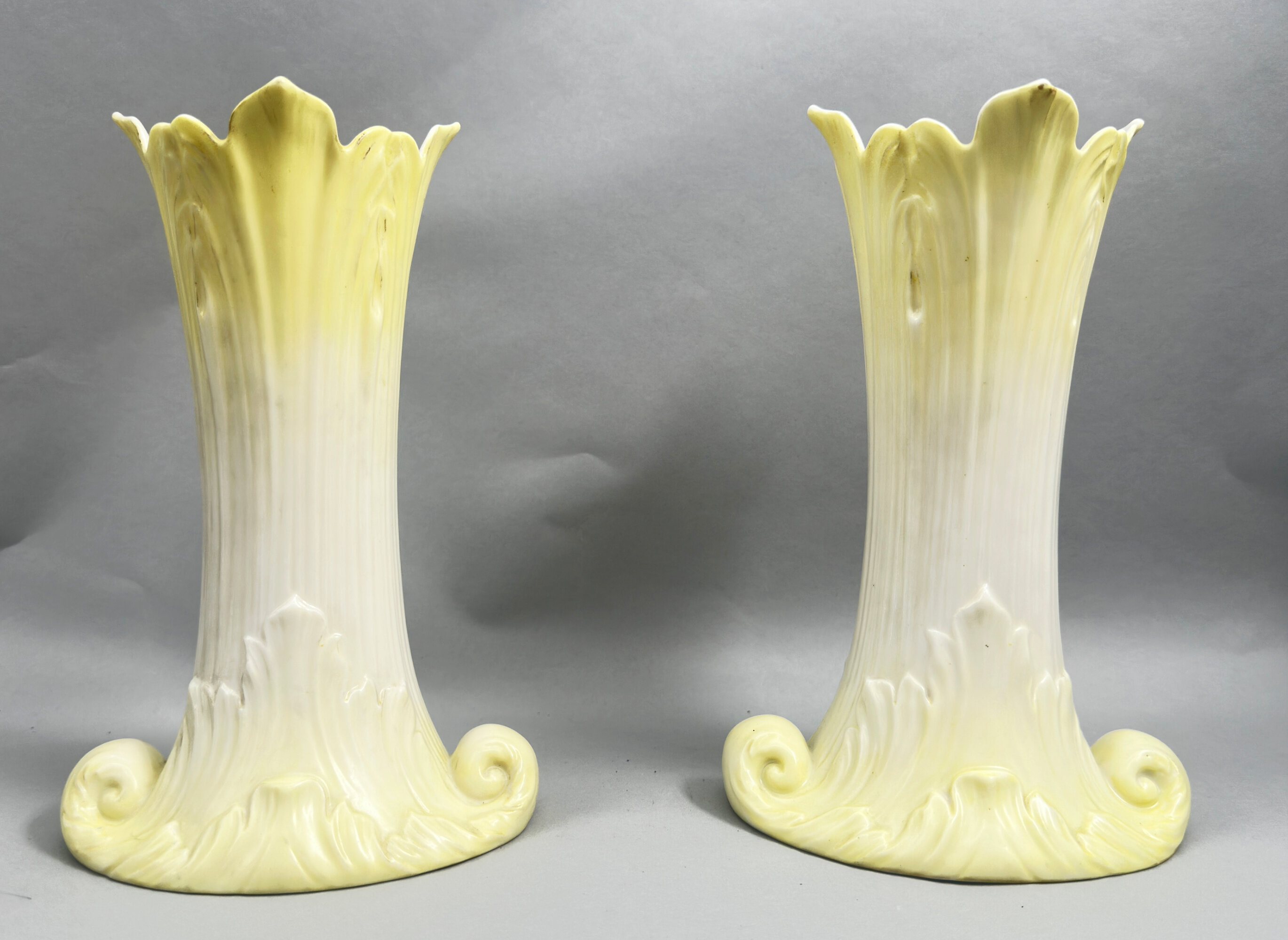
Pair of Royal Worcester Grainger and Co Vases, date mark for 1902
Price: £150The influence of the Art Nouveau movement, with its emphasis on organic and plant forms, is clearly seen here. The vases date to the early 1900s and were made by the ‘Grainger and Co’ branch of the celebrated Royal Worcester factory. The first porcelain factory at Worcester was set up in 1751 by John Wall (a doctor) and William Davis (an apothecary), along with 14 other businessmen. Fifty years later in 1801 Thomas Grainger (1783–1839) started a rival company ‘Grainger’s Worcester Porcelain’ and during the nineteenth century both companies traded successfully. However following the death of George Grainger, the son of Thomas Grainger, in 1889 the Grainger factory was sold to Royal Worcester who continued manufacture on its old rival firm’s St.Martin’s Gate site until finally closing the works in 1902. Ivory style porcelains were one of the specialities of this brief manufacturing period and the date mark ‘L’ which appears on these vases is for the year 1902, just before the two concerns were completely merged.
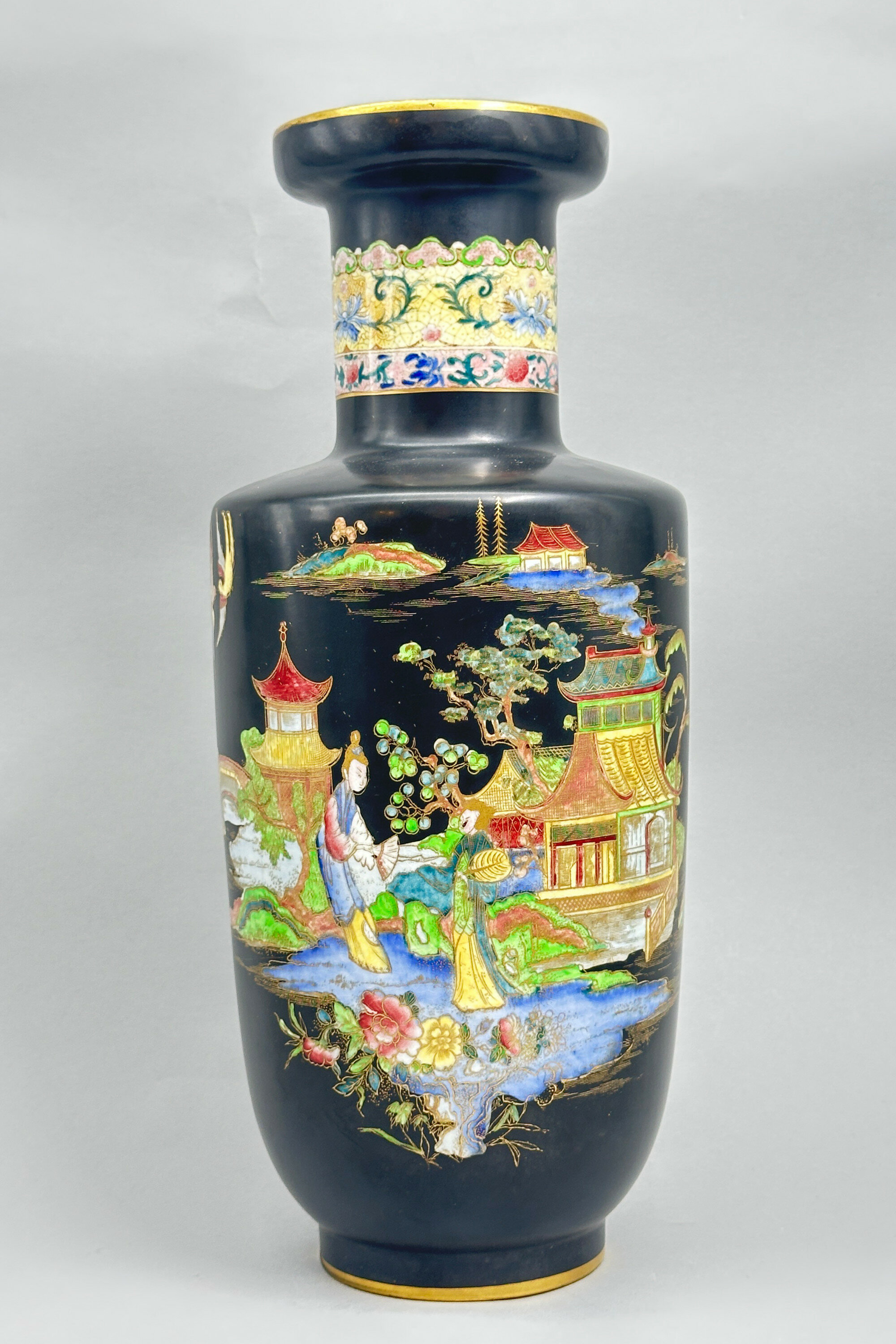
Mikado Carlton Ware Vase, 1920s
Price: £45Carlton Ware was the trade mark used by the pottery manufacturer Wiltshaw and Robinson, whose premises were located in Stoke on Trent, four years after the firm’s establishment in 1890. The firm mostly concentrated on decorative giftware and new methods of production introduced in the 1920s put it at the forefront of the earliest Art Deco pottery pieces produced, firstly with designs originating from Tutankhamun’s tomb and then with pieces with an Oriental influence of which this vase, in shape not often seen in this design, is a prime example.
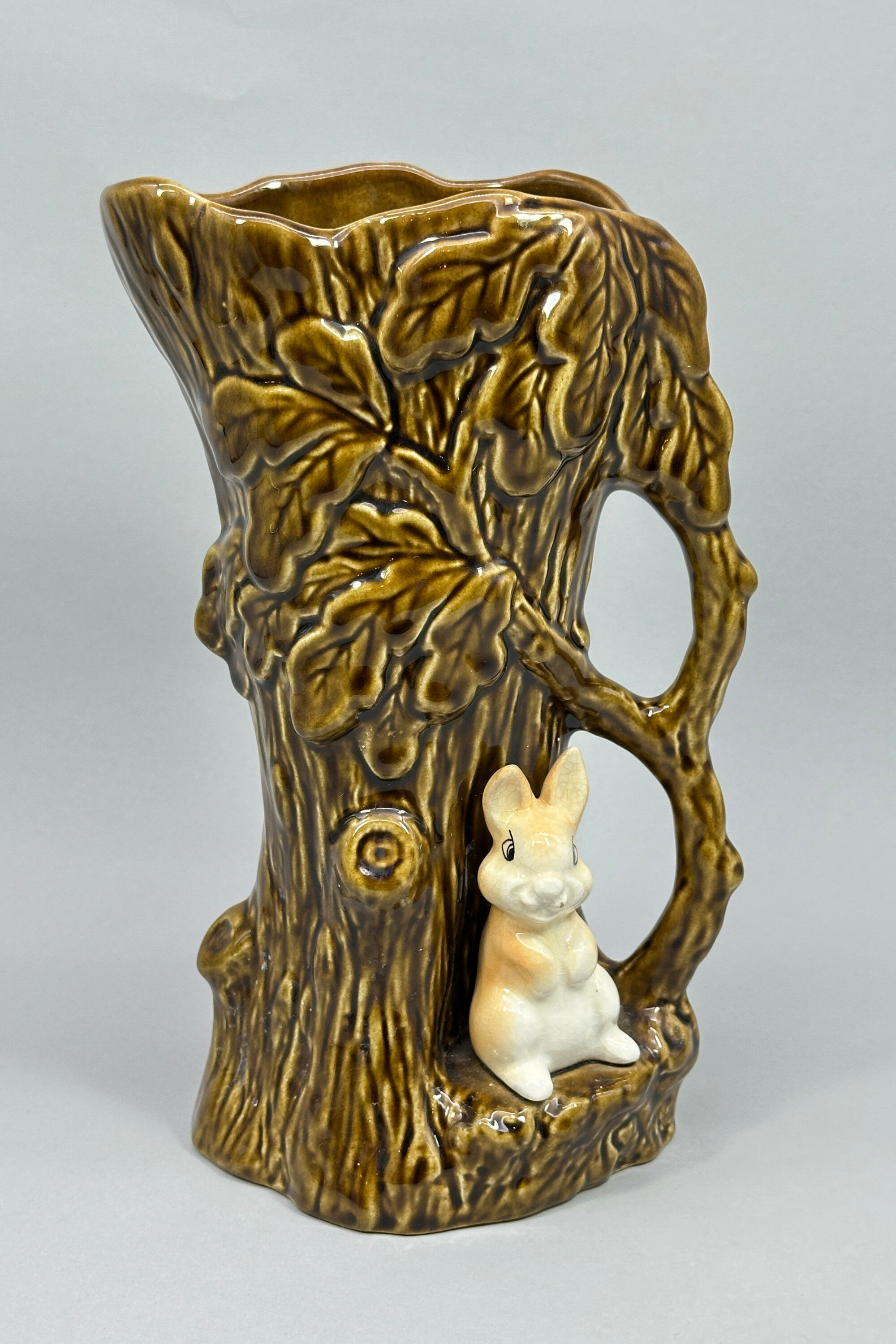
Sylvac woodland range Rabbit and Tree Jug, 1950s
Price: £35‘SylvaC’ (the name was written with a capital ‘C’ after registration of the trademark in 1938) was a trade name of Shaw and Copestake, a company formed by Mr. William Shaw and a Mr. Copestake around 1900. Mr. Copestake sold his shares to a Mr. Richard Hull after about six months of business and this partnership continued until Mr. Hull’s death in 1935. He was succeeded by his son, Mr. Richard Hull junior. In the following year, the business became a limited company. Various mergers and acquisitions followed and in the 1950s new premises were built and production expanded considerably continuing until the early 1980s when changing markets and increased competition forced the company into liquidation.
Sylvac were famous for imaginative glazed wares, particularly animals, and this jug is a typical and pleasing example of their work.
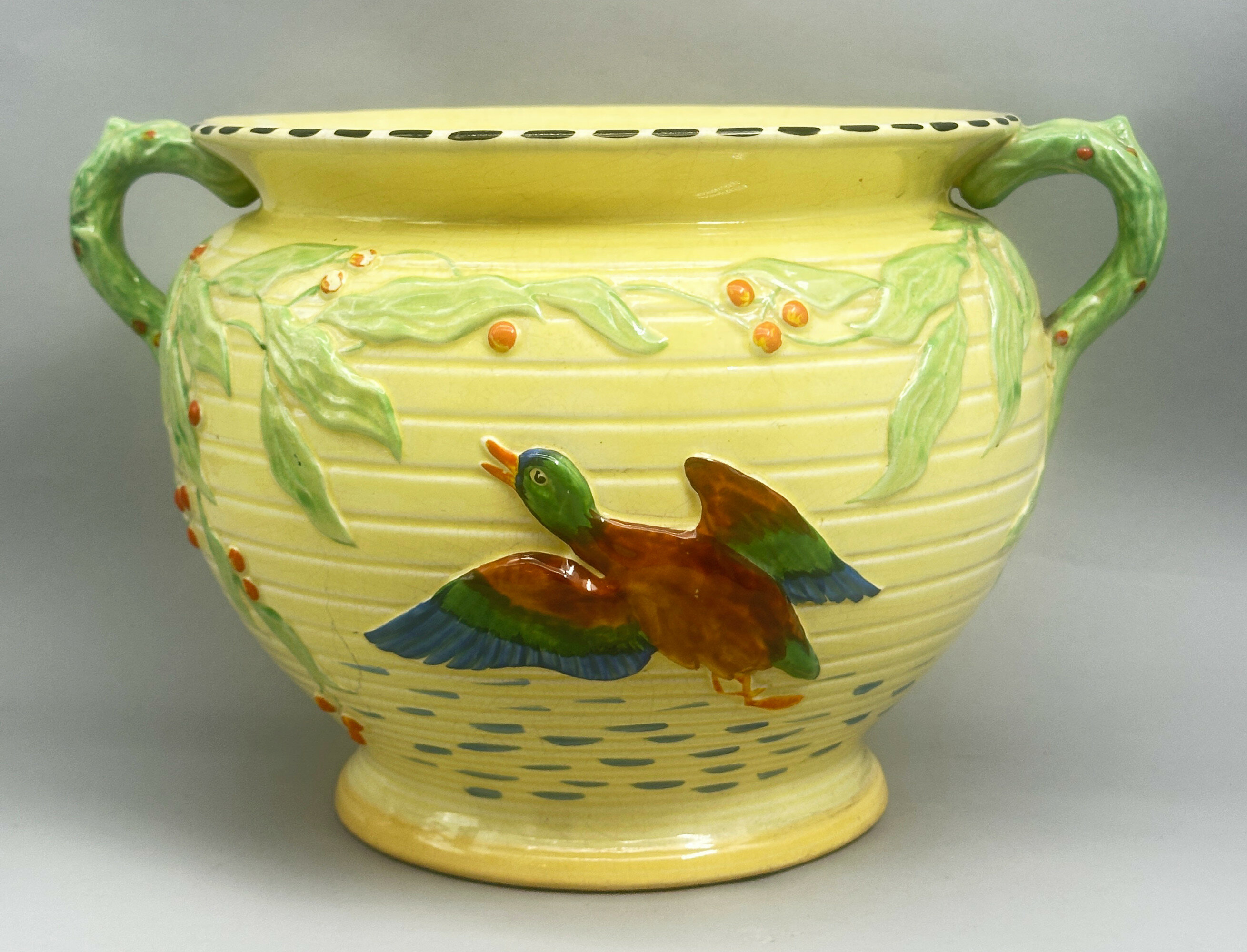
Falcon Ware Jardiniere decorated Mallard Duck and Foliage, 1930s
Price: £65Falcon Ware was the trade name for pieces produced by Thomas Lawrence, later Thomas Lawrence (Longton) Ltd, a business founded by Thomas Lawrence in 1885 which moved to the Falcon works, Longton, in 1895. In the same year he took his nephew, John Grundy into partnership and around 1920 Grundy became the Managing Director. Thomas Lawrence died in April 1932 and John Grundy became the sole proprietor until his death in 1938 when the business was sold to Grundy's son-in-law Mr Richard Hull (jnr) and Mr. E.J. Dennis and the name was changed to 'Thomas Lawrence (Longton) Limited'. At the same time the firm merged with Shaw and Copestake Ltd of which Richard Hull was a Director but the two businesses still operated independently until 1962 when the Thomas Lawrence business was fully subsumed by its partner with the ‘Falcon’ name ceasing to be used two years later in 1964.
Falcon Ware was known for colourful and decorative designs often with naturalistic themes. This jardiniere is an excellent and unusual example. The cipher ‘LG’, for Lawrence and Grundy, which is not so often found, implies a dating to the 1930s which corresponds with the general style of the piece with its hint of Art Deco associations.
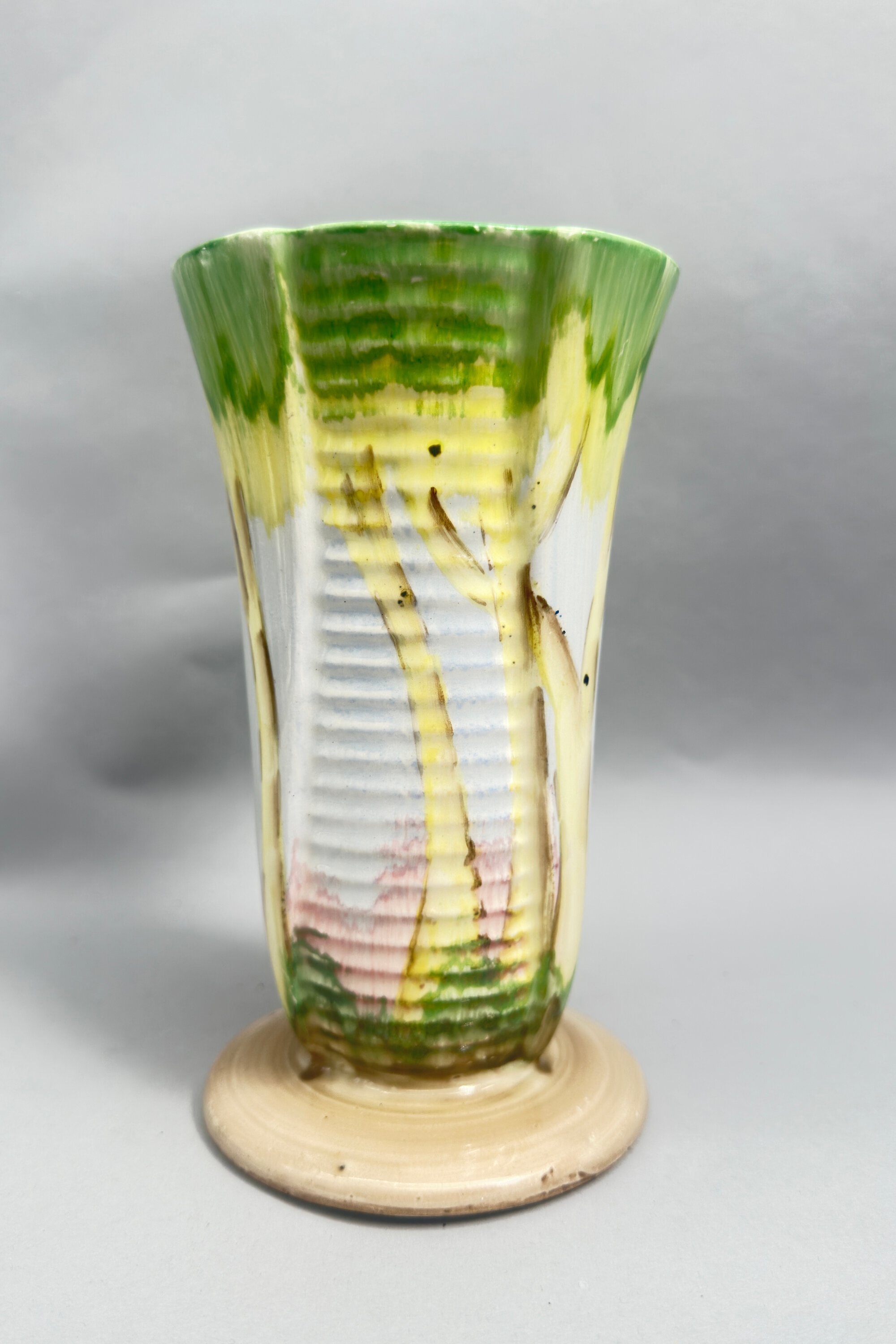
Art Deco style beaker form Vase, probably Beswick, mid C20th
Price: £35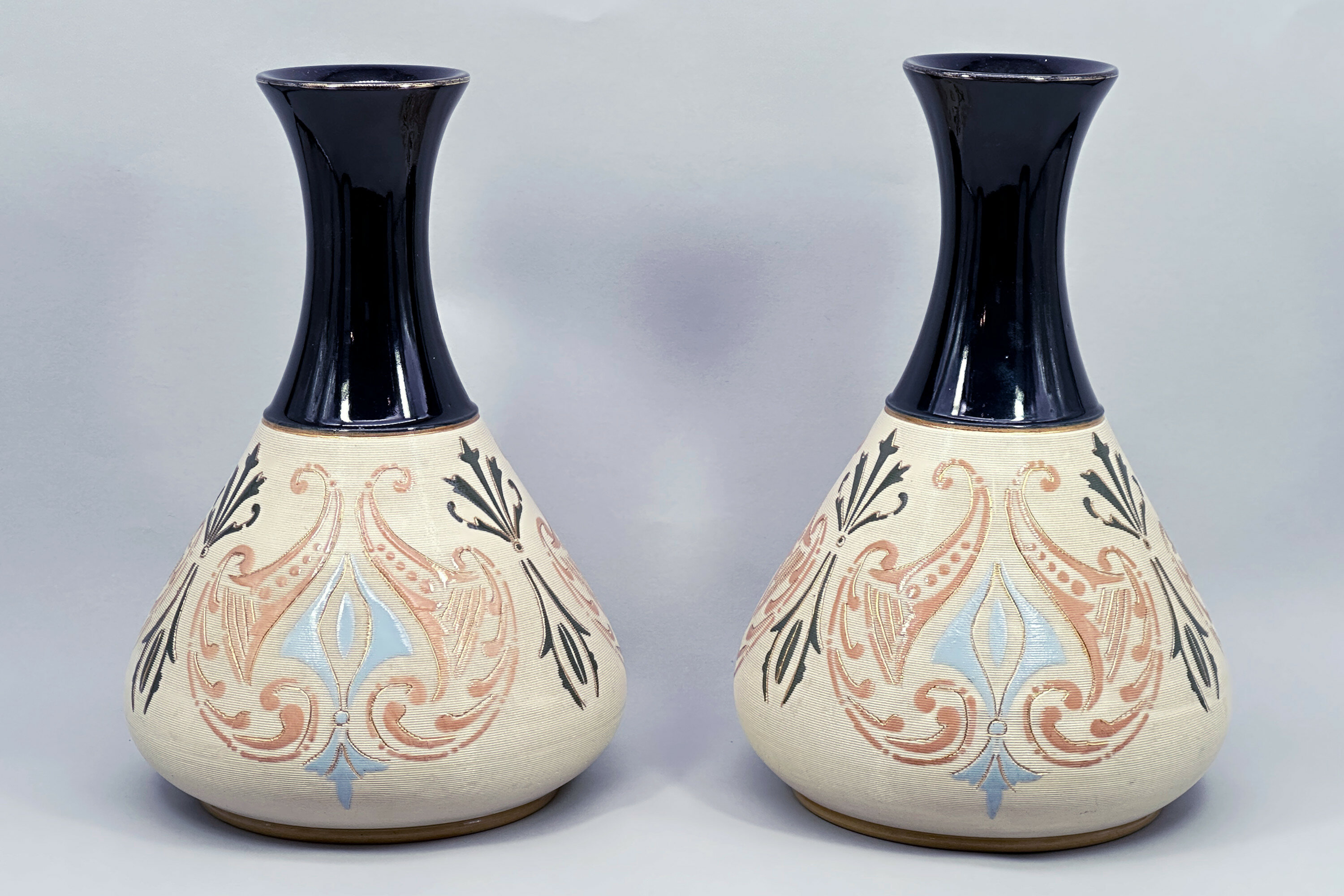
Pair of Lovatt and Lovatt Earthenware Vases, early C20th
Price: £95The Langley Mill Pottery was located in Langley Mill, Derbyshire on the Derbyshire – Nottinghamshire border. From its establishment in 1865 to its final closure in 1982, it went through five distinct periods of ownership, producing a wide range of stoneware ranging from utilitarian items and to high quality art pottery. This pair of vases dates from the third company that traded there, Lovatt and Lovatt. The Lovatt family had entered into partnership with the owner of the founding business at Langley Mill, James Calvert. From 1895 the business was in sole control of the Lovatt family and traded as ‘Lovatt and Lovatt’ until 1935. The early years of the twentieth century proved to be something of a zenith for them and a wide range of art pottery pieces were made which enjoyed great popularity. Production techniques were streamlined without a reduction in quality and in 1905, leadless glazes were introduced. These are proudly announced on the base of this pair of vases which are a fine example of the Lovatt and Lovatt style and probably date to 1913, indicated by the impressed numbers for that year.
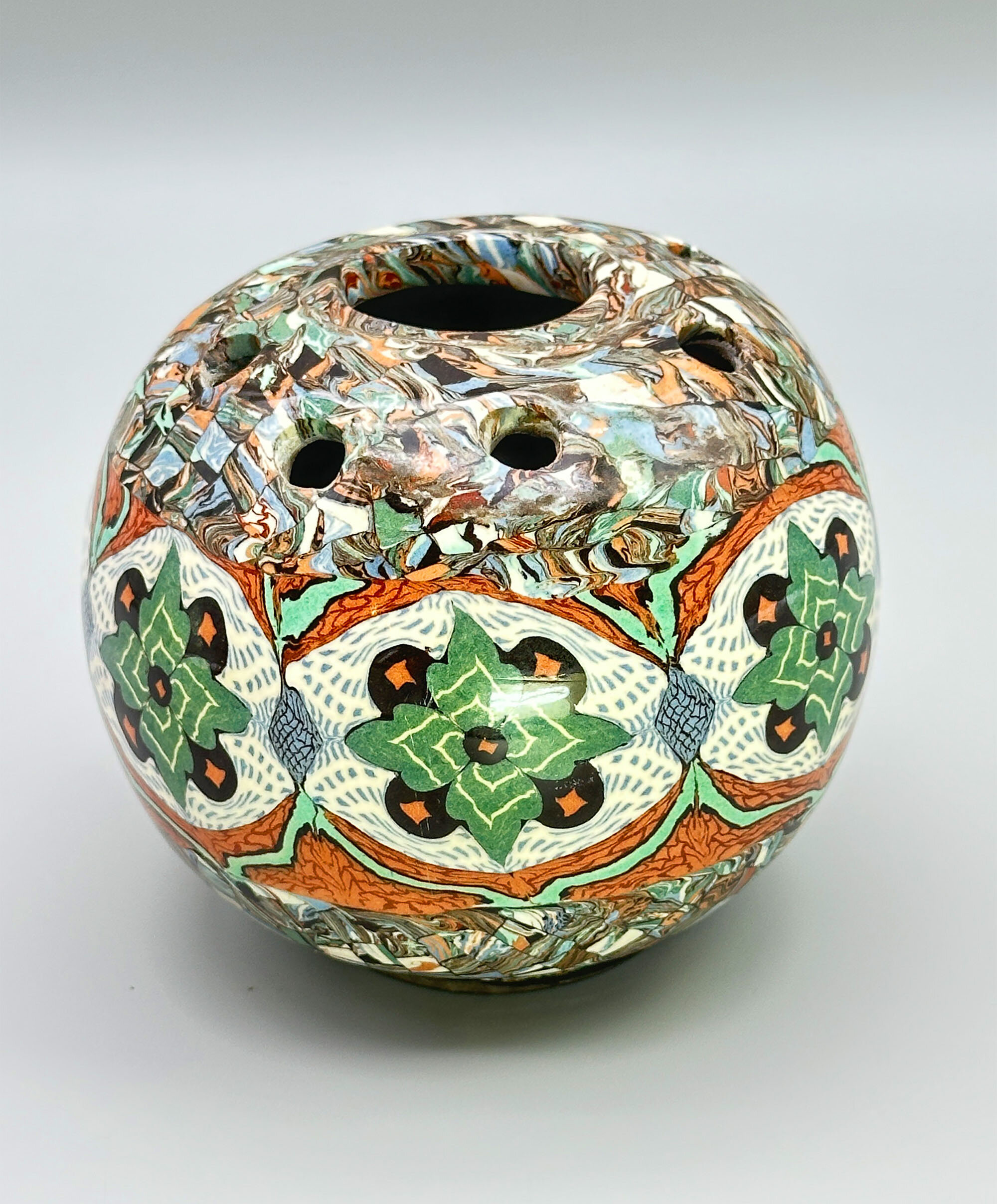
Vallauris Mosaic Pattern Vase, Jean Gerbino, signed, mid C20th
Price: £65Known for its ceramics since Roman times, when the deposits of clay found locally acted as stimulus for the production of pottery, the French Riviera town of Vallauris has been called the ‘city of 100 potters’. Pottery has been made there continuously since the classical period with a growth in production in the late nineteenth century followed by the establishment of various well known ateliers in the twentieth and the residence of Picasso himself who is said to have produced over 3500 pieces there.
Jean Gerbino Jean Gerbino (1876-1966) was a Sicilian ceramicist, who took French citizenship in 1928. He settled eventually in Vallauris and developed a unique technique combining mosaic and nériage (a mixture of coloured clays). The clays are coloured with oxides, hardened, and then assembled into plates to create colourful and distinctive mosaic patterns. These plates are then moulded, dried, and fired. The resulting forms are both distinctive and highly decorative, modern with a hint of the Art Deco era.
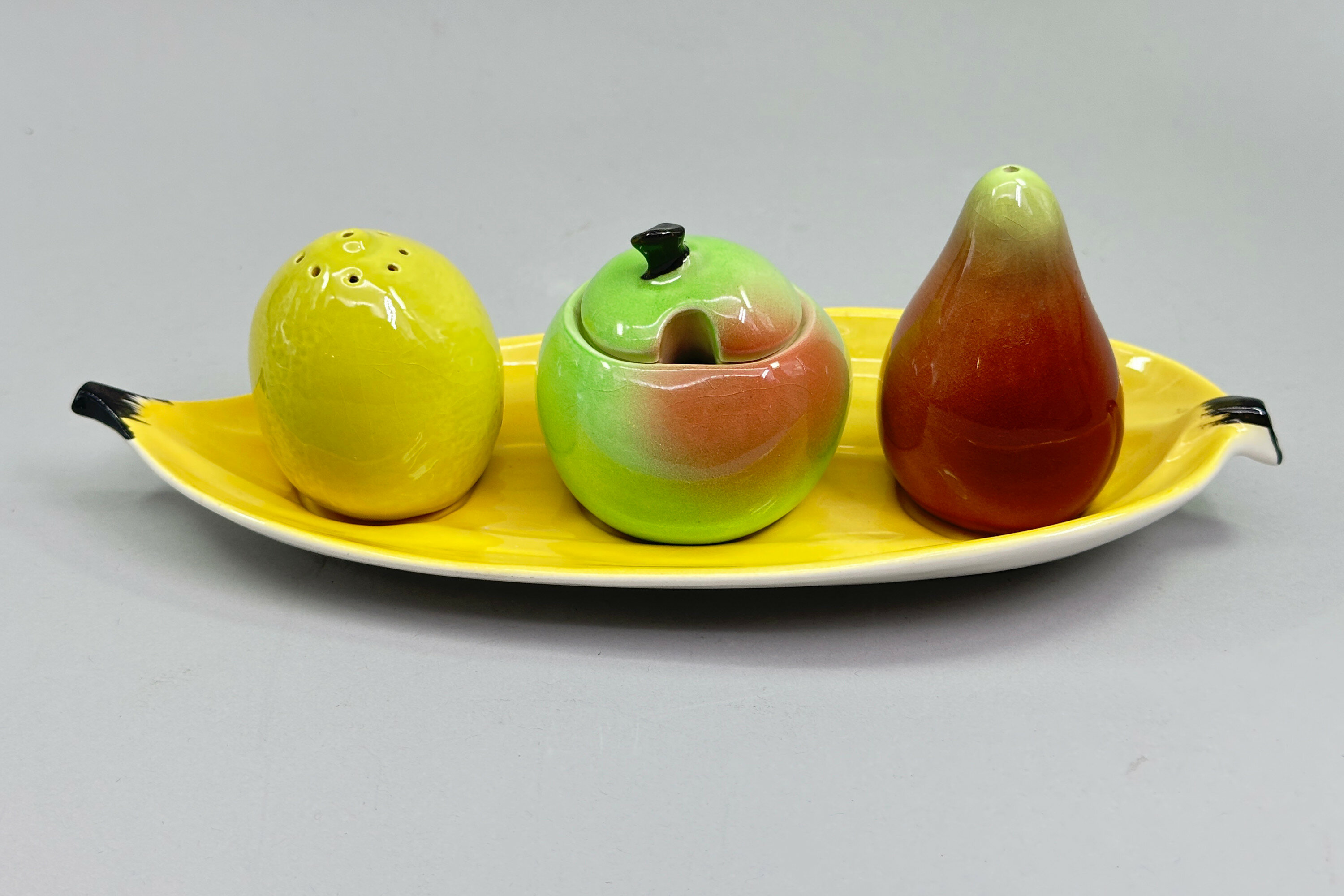
Carlton Ware fruit Cruet Set, Australian Design, 1950s
Price: £35Carlton Ware was the trade mark used by the pottery manufacturer Wiltshaw and Robinson, whose premises were located in Stoke on Trent, four years after the firm’s establishment in 1890. The well known script mark was introduced in 1928. The firm mostly concentrated on decorative giftware and new methods of production introduced in the 1920s put it at the forefront of the earliest Art Deco pottery pieces produced, firstly with designs originating from Tutankhamun’s tomb and then with pieces with an Oriental chinoiserie influence. Tablewares were also produced and this cruet set is an example of the imaginative designs made after the second world war and most likely dates to the 1950s. The appeal is obvious and today this set, complete with the original stoppers for the salt and pepper, can fulfil both a practical and decorative function.
Some examples appear to have an original matching spoon for the mustard pot; if that is the case, then it is absent here, but the spoon often illustrated looks quite generic and may not necessarily have been an integral component.
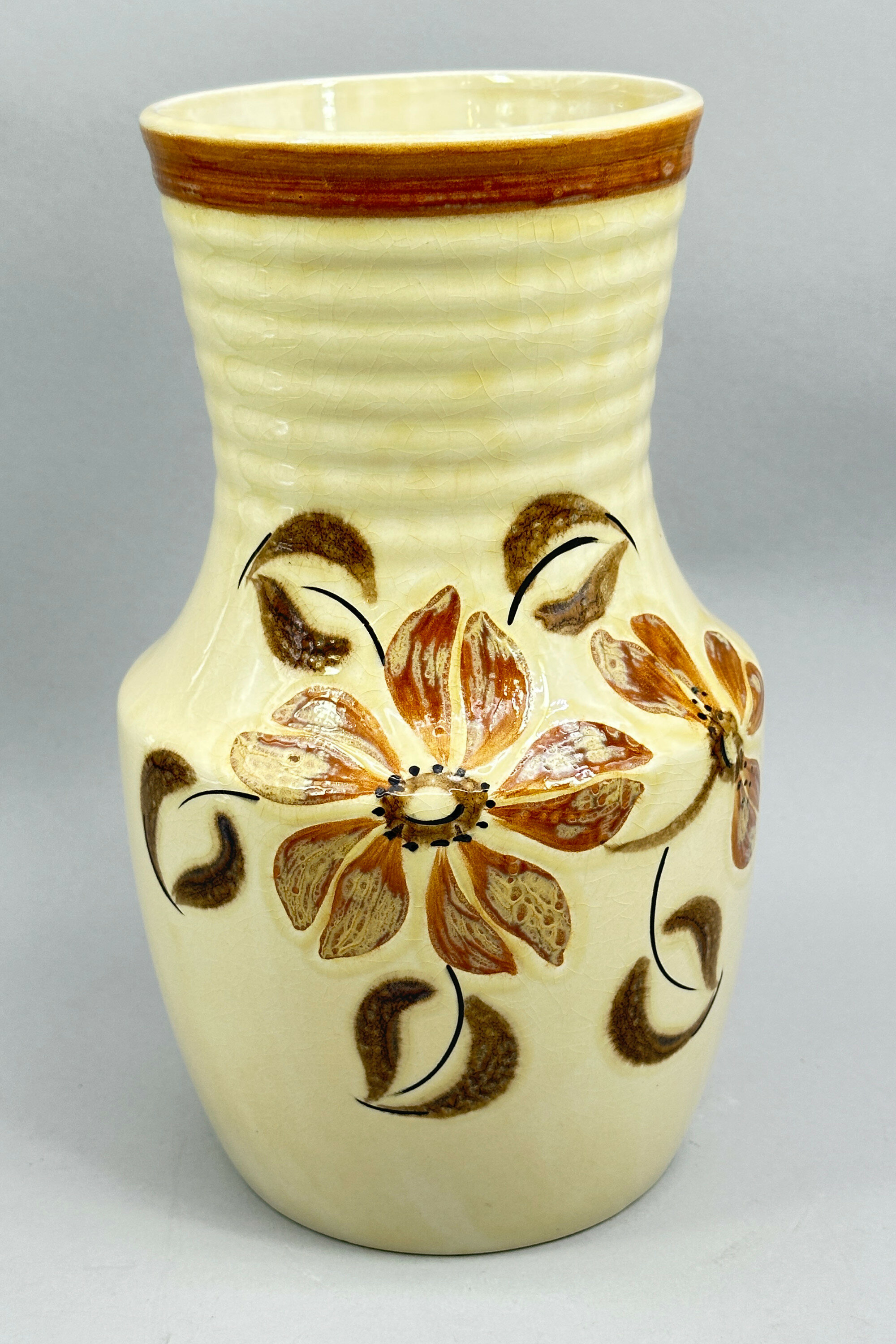
Vase with signature E.Radford and numbered 1267, mid C20th
Price: £45There were, in fact, two craftsmen working in the C20th British pottery industry with the name Edward Radford, father and son. Radford senior worked for Pilkington’s Royal Lancastrian Pottery in Manchester from 1903 until his retirement in 1936, acting as their main thrower. Radford junior joined his Father in 1905, but the First World War intervened, in which he won a Military Cross for his actions at Passchendaele in 1917 and afterwards he settled in Stoke on Trent, the heart of Britain’s pottery industry. An association developed with H.J.Wood’s Alexandra Pottery in Burslem who produced a range of wares bearing his name in the 1930s, although Radford himself may have acted as more a salesman than the designer. Production continued after the war and even after Radford’s retirement in 1948. The form of mark used here implies a later dating and both the shape, indicated by the model number underneath which is found on other vases with different decoration, and the decoration itself suggest the post war era, probably in the 1950s. There is, though, a modest charm here which would blend comfortably with a modern interior.
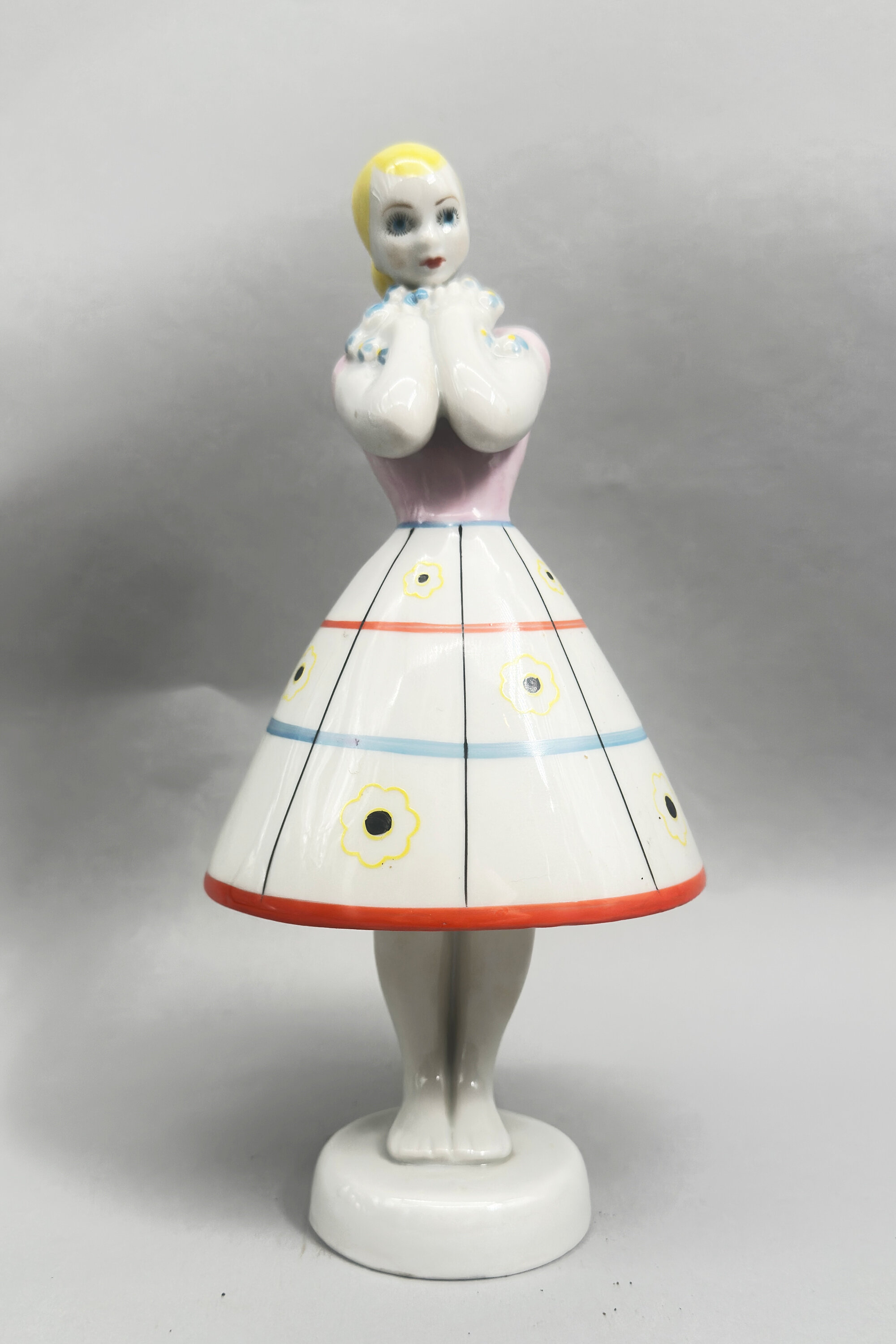
Figurine of a girl, Baranivka Ukraine, 1950s
Price: £55The Baranivka Porcelain Factory, one of Ukraine's oldest porcelain manufacturers, was founded in 1802-1804 by Mykhailo Mezer. Situated at Baranivka, at the time in Poland but now part of Ukraine, the factory was considerably assisted in its development by the discovery of rich clay deposits in the area. Production was continuous even during the Soviet era until the early twenty first century. Both the angular modelling and the abstract decoration of this piece point to a dating in the 1950s when production would have revived after the second world war and more contemporary styles adopted.
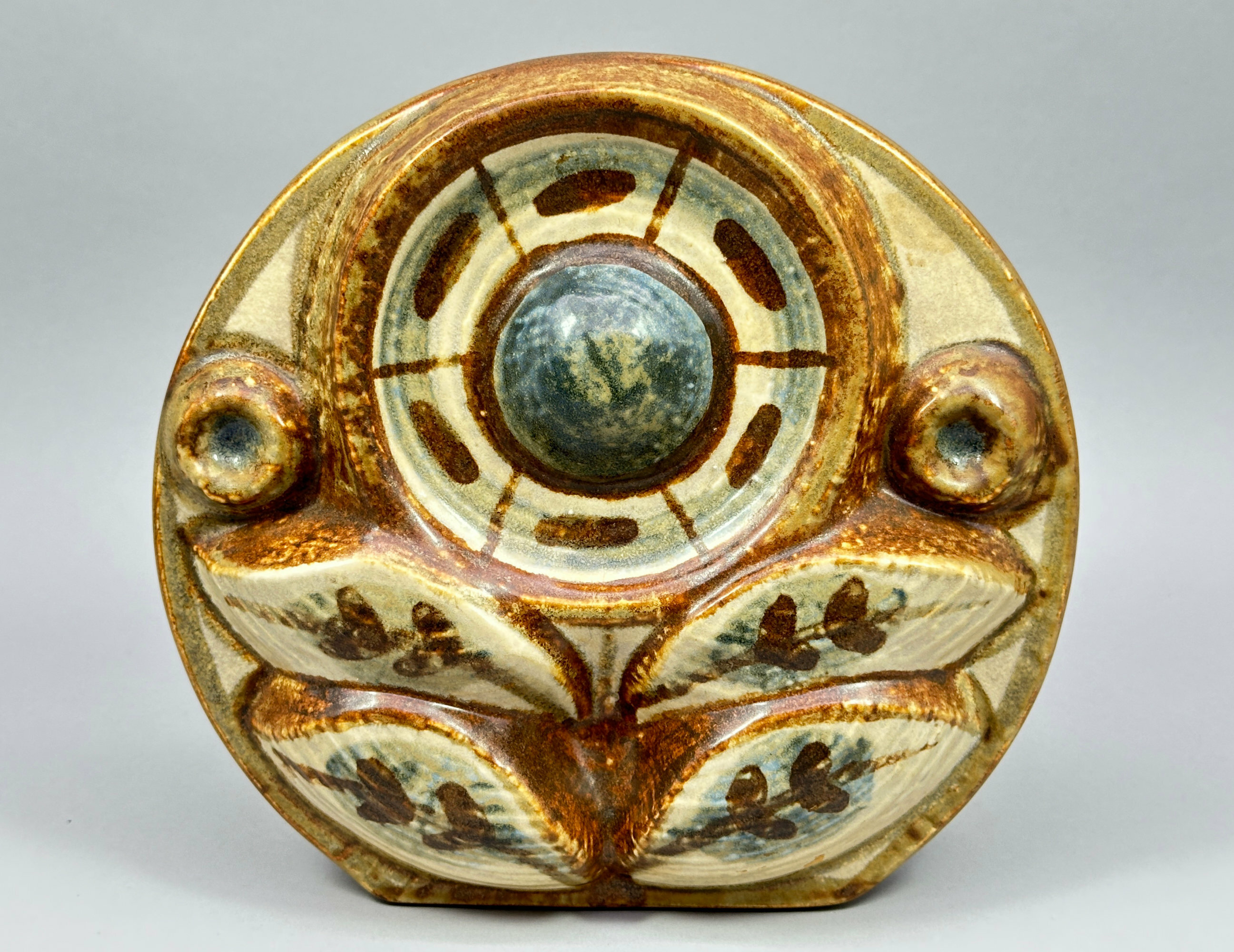
Wall Vase, designed by Noomi Backhausen, Søholm Stentøj, Denmark, late C20th
Price: £95The company Søholm Stentøj was founded by Herman Sonne Wolffsen and Edvard Christian Sonne in 1835 at Rønne, the principal town of Bornholm, a Danish island off the south coast of Sweden. One of the most respected of the Danish potteries it continued producing a wide range of ceramics until the firm closed in 1996. Noomi Backhausen was a designer for Søholm from 1966 to 1990 and set up her own pottery in Rønne in 1996 after the closure of her old employers. This wall vase is a typical example of her abstract organic designs and would be a worthy addition to a collection of twentieth century Danish design.
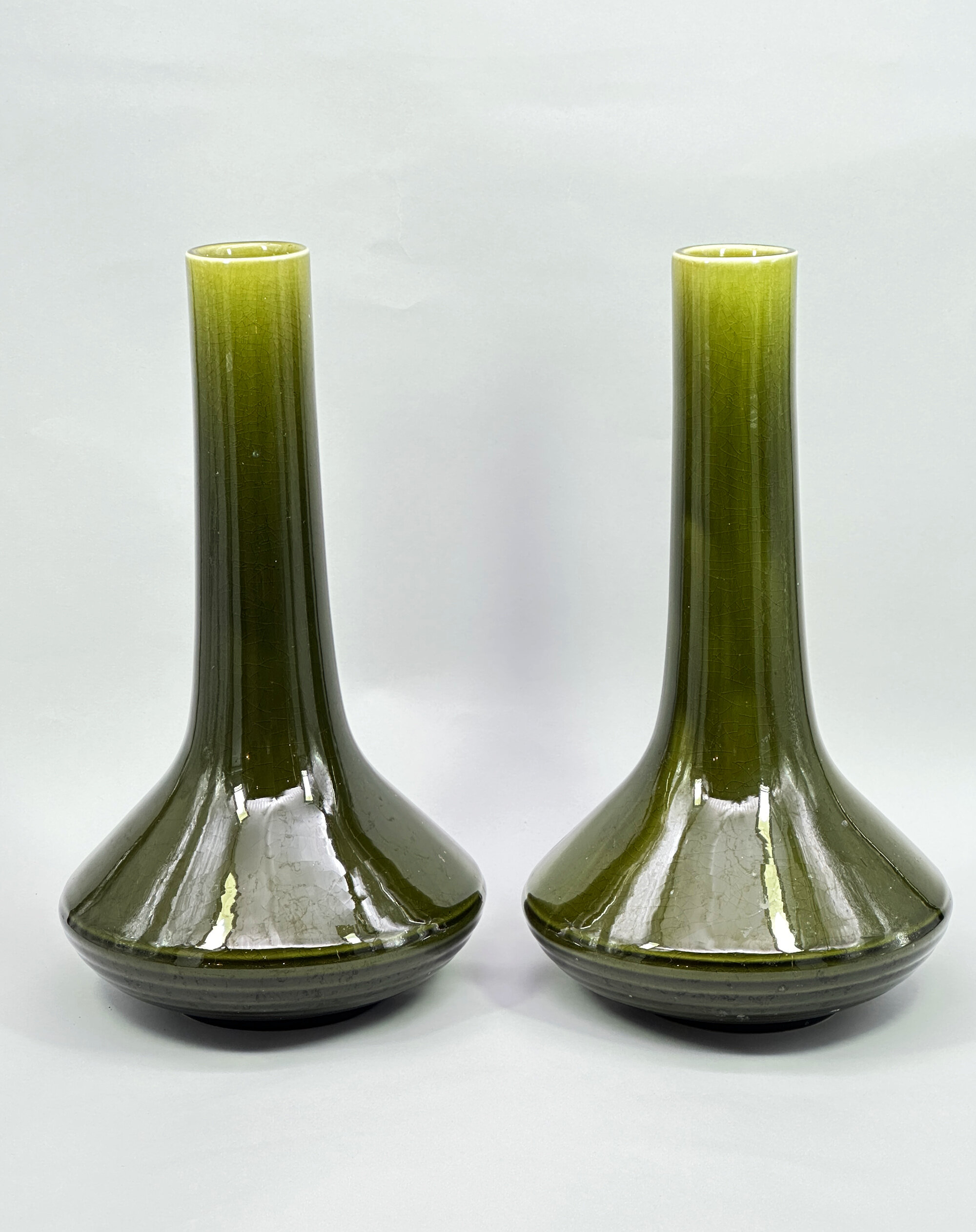
Pair of Green Glazed Bottle Vases, possibly French C20th
Price: £180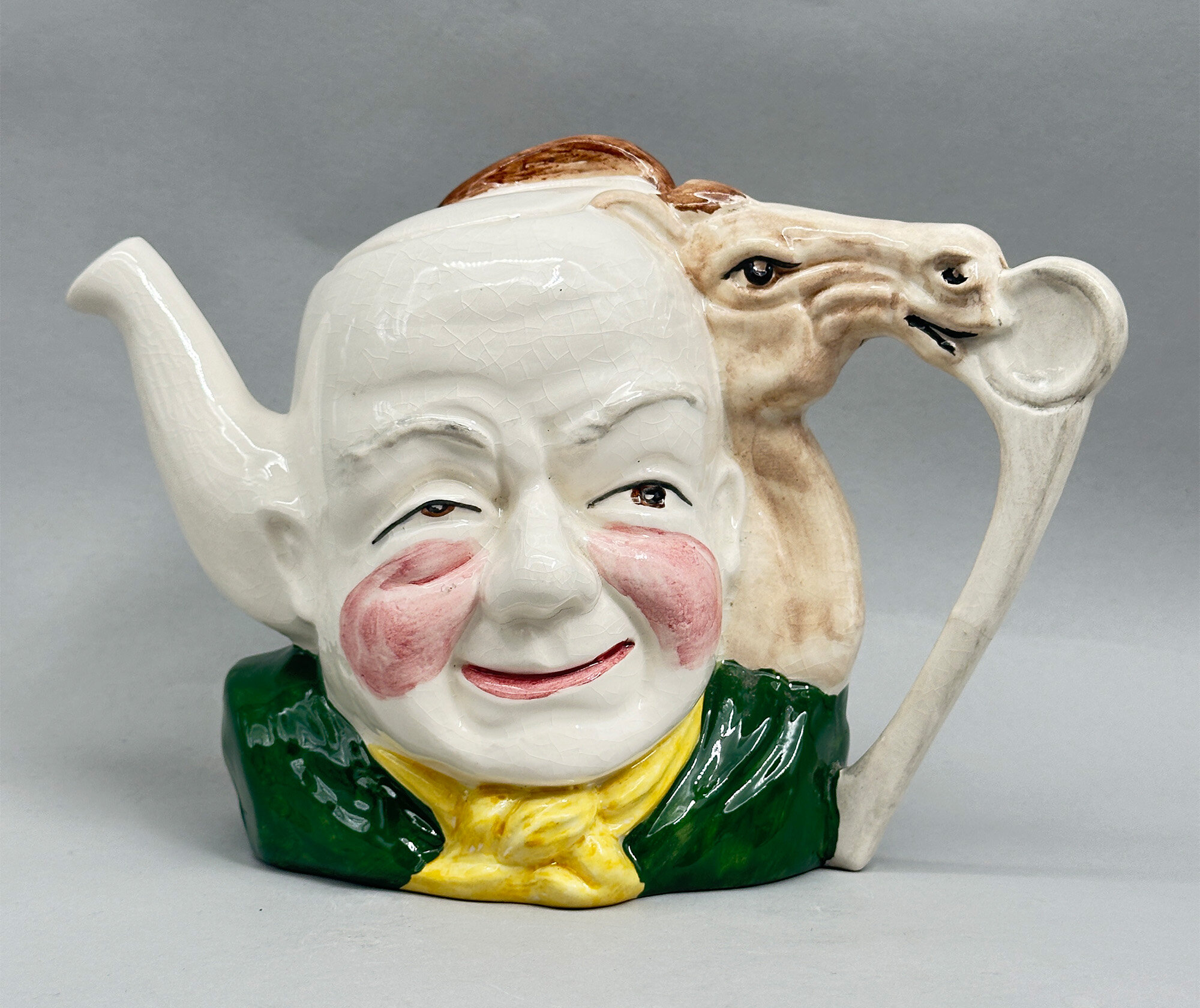
Crown Winsor Jockey Teapot, 1980s
Price: £35Crown Winsor was a short lived earthenware manufacturer at the Sylvan Works, Longton, Stoke-on-Trent, England, previously the premises of the firm Shaw and Copestake, who traded under the well known name ‘SylvaC’ and went into voluntary liquidation in 1982. A workers co-operative trading under the name of Longton Ceramics attempted to take the business over but with little success and eighteen months later the enterprise was fully taken over by United Co-operative Society and run under the name of Crown Winsor. The Co-operative society already owned the Windsor Pottery works and the Crown Clarence Pottery works which was the source of the ‘Crown Winsor’ name. Production centred on whimsical and novelty items, sometimes made from the old SylvaC moulds but demand proved weak and the business ceased trading in 1989. This teapot is typical of their range and the elaborate cipher underneath seems to read ‘CW’ grandly announcing a trade name which unfortunately had a very short life
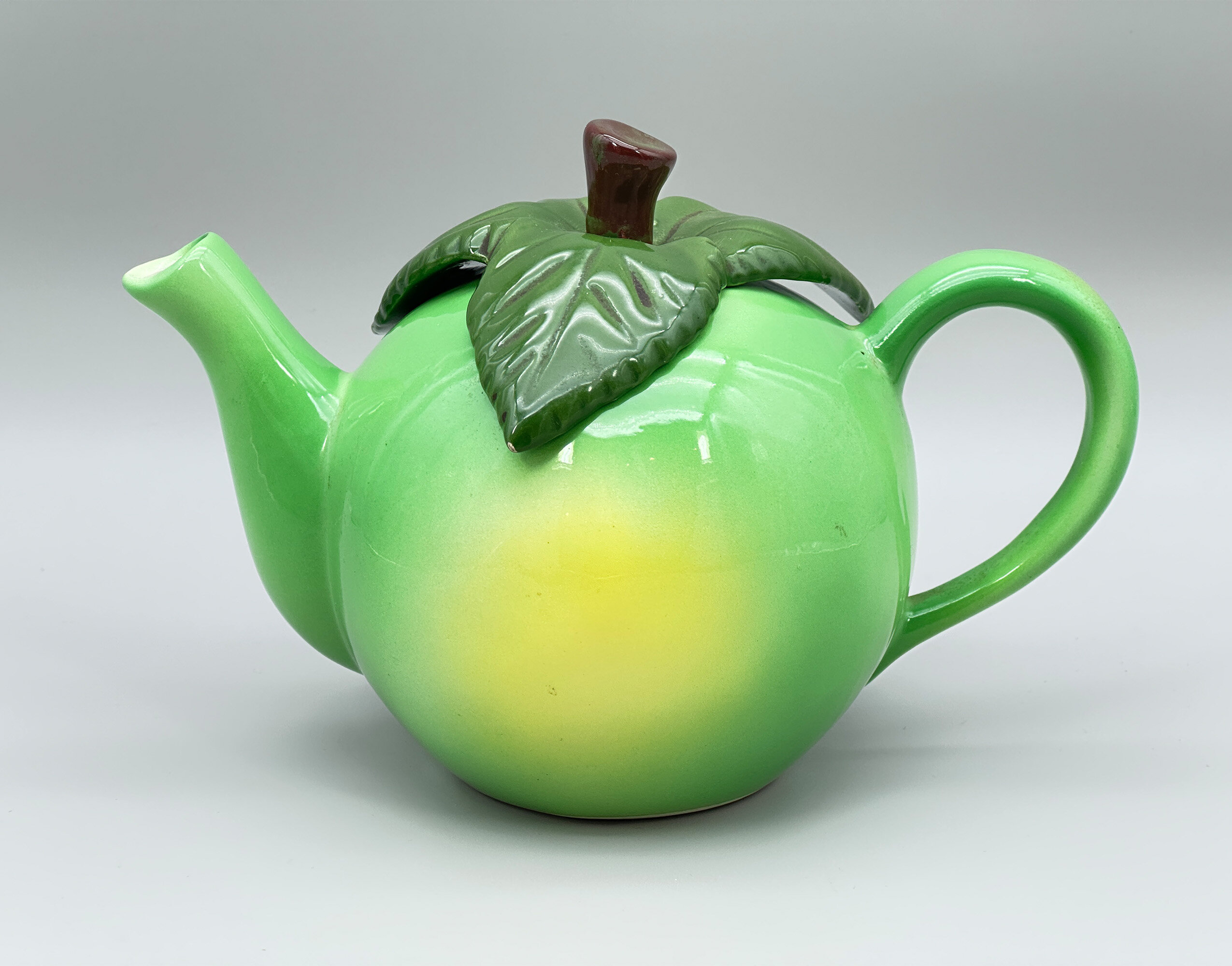
Novelty Teapot in the form of an apple, probably English, late C20th, early C21st
Price: £35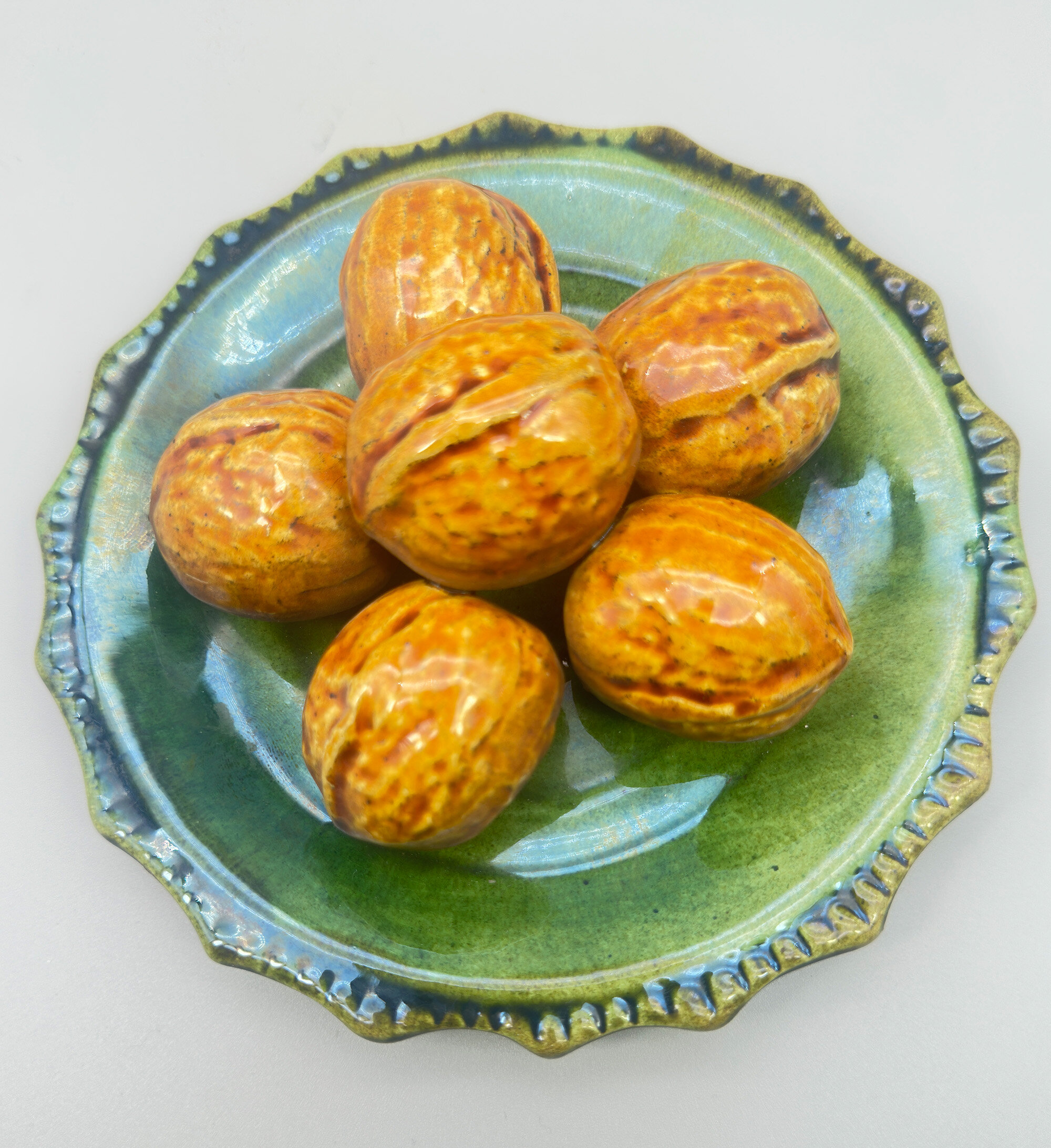
Majolica palissy style Walnut Dish, Roque Gaeiras, Portugal, second half C20th
Price: £45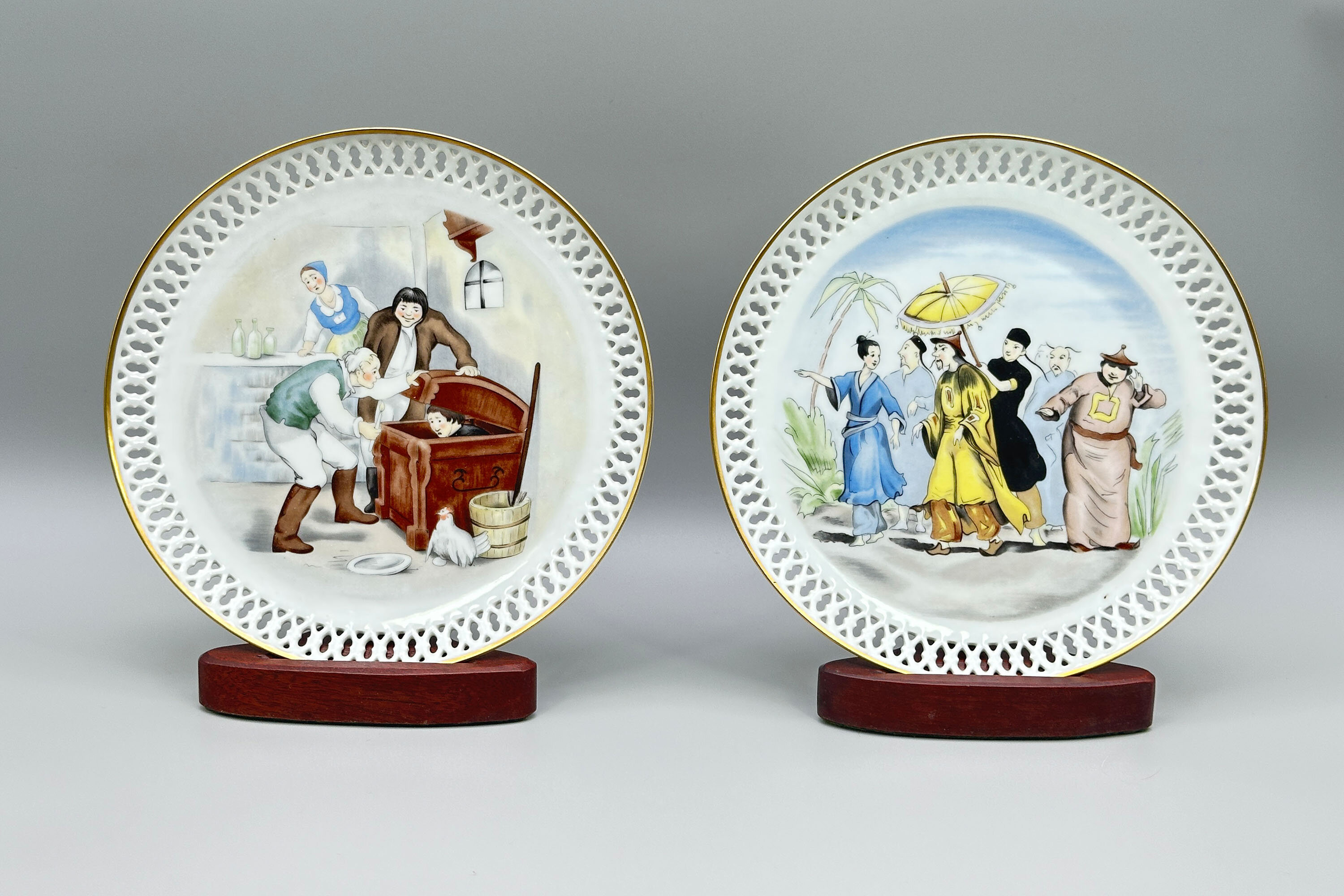
Two Bing & Grøndahl plates, scenes from Hans Christian Andersen, late C20th
Price: £45Bing & Grøndahl was established in 1853 by the sculptor Frederik Vilhelm Grøndahl and the merchant brothers Meyer Hermann Bing and Jacob Herman Bing. Their trademark, which can be seen on these two plates, was that of three towers, which was derived from the Coat of Arms of Copenhagen. Their designs proved popular and it is said that their dinnerware service in the ‘Seagull’ pattern could be found in one in ten Danish households in the 1950s. Eventually, in 1987 the company merged with its competitor, the Royal Porcelain Factory, under the name Royal Copenhagen, but some of the pieces produced thereafter still display the initials ‘B&G’ and the three tower symbol, as here. Originally sold with fitted boxes (not included here), these plates were probably produced in the early years after the merger and are sought after as collectors’ items today.
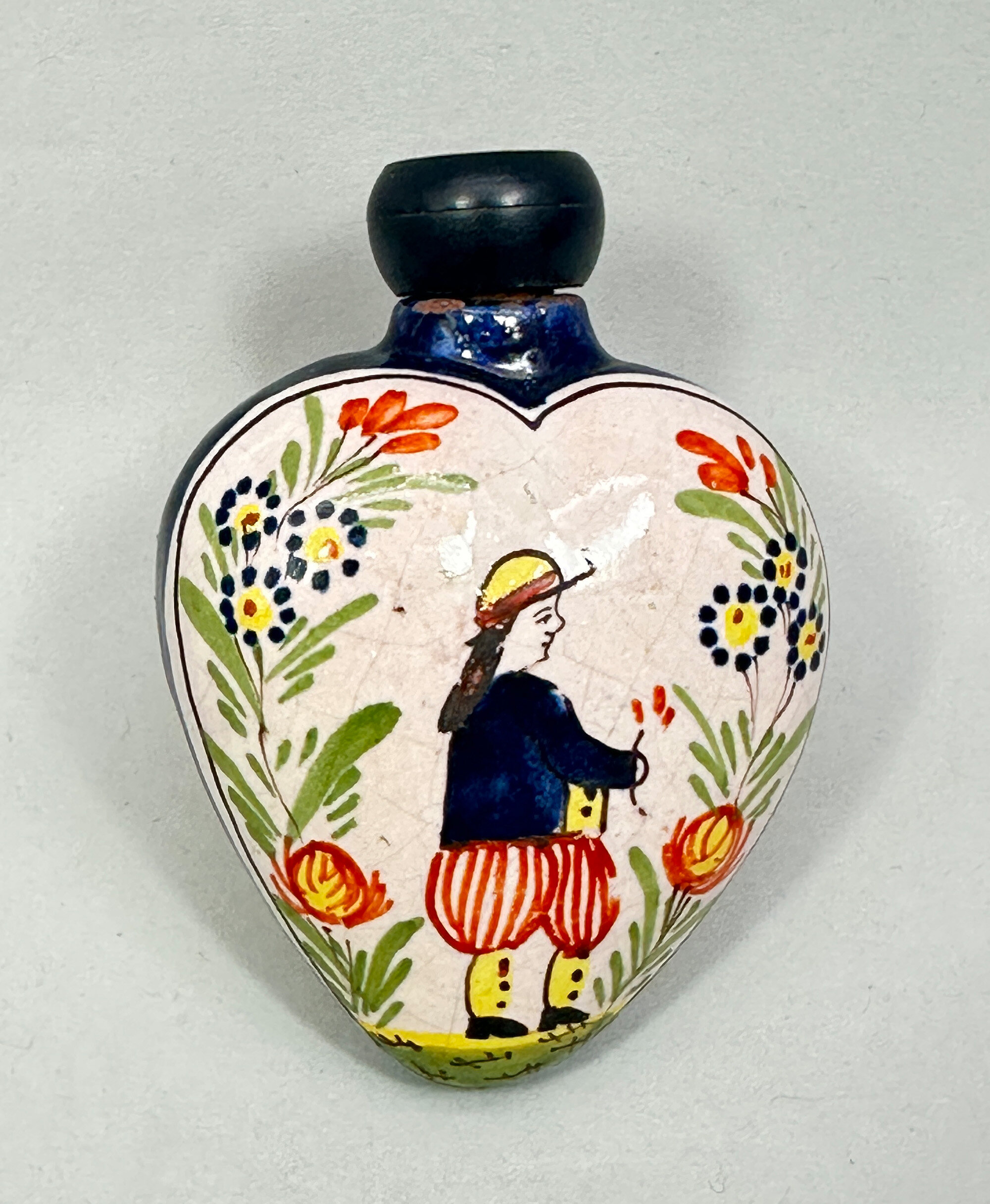
Faience Perfume Bottle and Stopper, Quimper France, C20th
Price: £75This bottle has the Breton gentleman on its front face and a fleur de lis to the reverse. The stylised lily, known as fleur de lis, became a symbol of the French royal family and France in general. It occurs, for example, on the Canadian flag but was also regularly used as a decorative motif by the Quimper potteries. These bottles can date to as early as the beginning of the twentieth century but a later time of production is probably a safer assumption here, perhaps to the 1950s. Few of these bottles survive with their fitted stoppers and the traces of cork to the top interior suggest that this stopper has been in place for some time and probably since the date of manufacture.